During the month of December 2016, I embarked on a 30-day challenge to validate a business idea, limiting myself to spending less than $500 to make that happen. I asked you to tell me what idea I should validate, too. The consensus: A hiking guide for California.
The challenge was a major success.
In just a few short weeks, I pre-sold 12 copies of a hiking guide (that didn’t even exist yet), generated $108 in revenue without a website and built an email list of 565 email subscribers who wanted to learn more about my upcoming hiking guide.
This was all done without using my existing audience, business, website, traffic or any other resources aside from my skills and the system I teach students who want to validate a business idea. I even had time to take a week-long vacation and visit my family for the holidays while validating this idea.
I’m telling you this because you can do it too.
In fact, you can take my system for validating a business idea and be far more successful than this little challenge was. I’ve used this system to generate more than $5,700 in pre-sales of a physical product for a previous business of mine. I’ve used it to pre-launch an online course and drive over $10,000 in revenue in one week without a large audience. I even used this strategy to land a $120,000 consulting contract and validate my content marketing business before quitting my day job.
If you want to start from the very beginning, read more about the rules of the challenge and dive deep into my weekly updates with an insane amount of detail around the execution of each tactic, click right here to jump down and begin reading from the day my validation challenge started.
For now, I want cover all of the major lessons I learned during my challenge to validate a business idea in 1 month. After analyzing all of the steps I went through during this challenge, looking back at how I built my previous businesses, interviewing dozens of entrepreneurs on this subject and applying my system from The Launch Formula, I’ve boiled it down to just 9 simple steps to validating a business idea.
But first, let’s quickly cover what validation actually is, what it isn’t and why it’s important.
What is Idea Validation?
- Validation is designed to give you you reasonable certainty your business will have a sustainable, growing, paying audience in a matter of days or weeks, rather than wasting months or years building a final product nobody will pay for. It’s as much a way of thinking, as it is a step-by-step process. The end result validation attempts to achieve is most often meeting a desired number of pre-orders or waiting list subscribers who’d purchase a basic proof of concept of your idea—a minimum viable product that solves the most simple form of the problem you’re attempting to address.
- Validation isn’t a guarantee of success and it most certainly isn’t easy. It’s not as simple as putting up a waiting list and hoping people miraculously discover your offering & fork over their hard-earned money for something that doesn’t exist yet. It takes work to build confidence, inspire trust and convince a community that you’ll be able to deliver enough value in exchange for the price you’re asking. Validation is designed to give you your first paying customers and foundation for future growth.
Know that my definition of validation has been formed over years of experimentation myself, from all of the best business books I’ve read and the online business courses I’ve both taught and taken. I’d recommend reading this post all the way through from top to bottom, but if you prefer to jump around, here’s a hyperlinked table of contents that’ll take you straight to each stage of validating a business idea.
9 Steps to Validate a Business Idea in 30 Days (With Less Than $500)
- Find a Profitable Niche (That You Care About)
- Leverage Your Strengths and Outsource Your Weaknesses
- Create an Early Feedback Group
- Have One-on-One Conversations With Your Target Market
- Develop a Competitive Advantage
- Grow Your Email List
- Build a Proof of Concept
- Launch and Get Pre-Orders From Your Email List
- Continue Building and Tweaking With Feedback
Disclosure: Please note that some of the links below are affiliate links and at no additional cost to you, I’ll earn a commission. Know that I only recommend products and services I’ve personally used and stand behind. When you use one of my affiliate links, the company compensates me, which helps me run this blog and keep all of my in-depth content free of charge for readers (like you).
Now, let’s dive into this.
1. Find a Profitable Niche (That You Care About).
Business ideas don’t just fall down out of the sky. They’re not delivered by a magic genie. And while you can find a lot of inspiration on the types of businesses you should consider starting, you shouldn’t pursue a random idea just because someone told you it’s a good idea.
In a study by CB Insights covered on Forbes, a whopping 22% of failed startup founders cite their primary reason for failure as either never having a true interest in what they were building or losing focus on the goal they set out to achieve.
Put simply, they were never really interested in their business concept.
The best business ideas come from your strongest areas of interest.
I’m so adamant about only building a business around a real interest of mine because I’ve chased pure market opportunities in the past, without really caring about what I was building… it doesn’t end well.
When the going gets rough (it will), you need to be motivated beyond just the lure of dollar signs (and more than just a stable of motivational quotes to get you through 😉.) If you’re only in it for the money, you’ll either give up or be quickly pushed out of the market by people who genuinely care about what they’re doing and the people they’re helping—they’ll be more motivated than you.

If you’re not sure what your interests are, or which of them may potentially lead to a profitable business opportunity, start by answering these questions:
- What are your hobbies?
- What is the most meaningful part of your day?
- What are some topics you could enjoy writing a 1,000 word article about?
- What do you love doing?
- What is an achievement that’d make you feel particularly proud of yourself?
- Are there any specific aspects or functions that you love about your job?
- How about any childhood dreams you still find intriguing?
- If you had to choose just 1 thing to be remembered by, what would it be?
For my challenge to validate a business idea, I went through these questions and landed on 3 general topic areas I knew I could potentially build a business around—I didn’t know how or what, but that’s not important at this stage.
What’s important is that I focus on the next incremental step that’d get me closer to my goal of validating my idea. For now, that meant picking a niche to blog about, not worrying about how I was going to make money with the idea today.
So, first things first. That brought me to my top 3 options of hiking in California, cooking hacks (which I’m now exploring with a side project, VeganTable) or long distance running.
My favorite personal litmus test for choosing these was whether or not I could write a 1,000 word article about the topic and actually enjoy doing it. To me, that proved I was actually interested in the subject matter and have enough confidence in my knowledge to publicly share about it.
If you don’t personally identify as a writer, consider Joel Saltzman’s thesis in If You Can Talk, You Can Write, where he teaches people how to become writers by starting them off writing only about the interests they find themselves talking about most—which is also the clearest indication as to what you could potentially build a business around.
After choosing these topic areas, I asked my readers to vote in the comments (below) and hiking in California emerged as the winner.
If you want more questions and guidance around uncovering profitable niche ideas, there’s an entire lesson & worksheet dedicated to this topic in my upcoming course, 30 Days to Validate. You can sign up to get updates and early access right here.
Want to find a profitable niche business idea this week? Join my free online course Find a Profitable Business Idea today.
2. Leverage Your Skills and Outsource Your Weaknesses.

If you want to become successful as an entrepreneur, you need to be great at what you do—and you must focus on giving yourself as much time as possible to leverage those abilities (in addition to #1, being interested in what you’re solving). Here’s why.
It’s proven that focusing on your strengths makes you more confident in your work (via Psychology Today).
Choosing to work with your strengths also helps you unlock more creative solutions to the problems you encounter, because you’re more comfortable and in your element.
Studies have also found that those who engage their strengths on a daily basis report higher levels of positivity, which helps create a buffer against the negative effects of stress, fatigue and trauma.
When you choose to leverage your strengths within your business, you’re maximizing your opportunity for success by setting yourself up to be more confident, creative, positive and less prone to becoming overly stressed. This has been essential in helping to grow two of my newest side projects—a business, finance and credit blog called MoneyTalk, as well as a WordPress tutorial and advice blog called SmartWP.
In business (and in this challenge to validate a business idea), you’ll constantly be racing against the clock to achieve meaningful results. And when you’re operating outside of your core strengths, you’ll encounter more unexpected challenges, thus having to account for more of a learning curve along the way.
When it comes to validating a business idea, fast and simple is the name of the game.
To move as quickly as possible without wasting time and money, you need to focus on the skill set you already have and make it work—which I promise you is possible. This is the foundation for how I manage opportunities within my business.
If you’re not sure what your most marketable skills are (like blogging skills), I have a free skill assessment guide that’ll walk you through the process of discovering your skills. You can pick it up right here.
Focusing on leveraging my strongest skills translated directly into this challenge to validate a business idea, as a clear sign that I wouldn’t be investing time in any of these areas outside of my current expertise:
- Not going to build a website
- Not going to design any fancy visual content
- Not going to create an app
- Not going to make a physical product
- Not attempting anything else far outside of my current skill set
That left me with having to lean primarily upon my skill of writing to validate this business idea—which I view as one of my strongest. If I hoped to have any chance of success validating this idea, I didn’t have time to go out and learn new skills, take classes or meet with coaches for weeks or months.
It’s not that investing in new skills is a waste of time—I wholeheartedly believe education is always a good investment in your future. However, in order to validate this business idea, I didn’t need to build new skills. And you don’t either.
Delaying this challenge in any way because I felt I didn’t have the right skills would’ve been a major excuse. I’m not into making excuses.
“But Ryan, you already have clear, marketable skills…”
Stop wasting time complaining. Seriously. You need to become the master problem-solver in your business (and life).
Today, that means working with the skills you have and doing everything you possibly can to validate your business idea with real, paying customers before going out and investing time or money into building skills for your project.
If you decide to really make this happen despite any obstacle ahead, you can build a business that’s uniquely suited for you.
You can do it without having to go out and learn complex new skills, as long as you’re willing to be honest with yourself about what’s outside of your expertise. Then, you’ll have to actively outsource those tasks to sign a freelance contract on platforms like these remote job sites, by bringing in complementary business partners or hiring the right employees.
For this challenge to validate a business idea, I knew I’d have to focus on leveraging my writing skills. No complex tech tools or fancy integrations. All I used was a series of (free) Google Docs and Google Sheets that’d allow me to side-step wasting time on anything outside of my wheelhouse.
On top of just the hard skills I planned on leveraging for validating this business idea while keeping my core business running at full speed, I knew I’d have to get serious about managing my time in order to make this happen.
I’m a morning person (4:30am is a casual wake up time for me), so I turned to some great advice from my friend, Chris Winfield on how to construct a morning routine that’d help set me up for success with this project.
Each weekend, I scheduled blocks of time on my calendar for when I’d be dedicating time to working on this project during the week ahead—everything that makes it into my calendar gets done. If it’s not in the calendar, it probably won’t happen.
Now that I had these ground rules set in place, I could move on to the first critical (often neglected) stage of validating a business idea: Creating an early feedback group.
3. Create an Early Feedback Group.
One of the biggest takeaways from my challenge to validate a business idea last month was that sharing your work is hard, even for me still.

You’re exposing who you really are, making yourself vulnerable and creating opportunities to be judged on the quality of your work.
The more people I shared my broad hiking website idea with, the more great things started to happen for me.
The goal of creating an early feedback group of people who are within your target market, is to make sure that you’re building something they’ll actually need—and want bad enough to pay for. That’s why having customer feedback is so crucial.
But, before I could start telling people about my idea and asking them to join my feedback group, I had to at least have a rough idea of what I was pitching them—a guess about the main problem I was seeking to address.
Crafting a quick elevator pitch.
Here’s how I did this in-action with my challenge to validate a business idea related to hiking in California.
With a focus on value, I sat down and wrote out a list of what I thought was missing from current sites that tried to be hiking guides, adventure manuals and general resources for doing cool stuff outdoors in California.
Surprisingly, I found that most of the websites talking about hiking and outdoor adventures in CA had pretty mediocre content—images were often stock photos, the written content tended to be overly generalized and not very helpful for hikers seeking to capture great photos while they’re on a hike (a narrow niche I think I can address very well).
I thought there could be a serious opportunity for having hiking guides and outdoor adventure resources that have a significantly higher quality of images and other content.
So, my hypothesis was that by going into content mediums like drone footage and 360 cam images (that others aren’t trying in this space yet), I’ll be able to win some readers that appreciate new innovations and higher quality.
After 20 minutes of research, I came up with this short elevator pitch that I could customize for each person I’d be reaching out to:
Hey [First Name]! I’m building a new site I thought might be up your alley as a fellow adventure junkie.. it chronicles all of the best places to find adventures in California, go on awesome hikes and capture unique photos from each spot while you’re there. I’ll be grabbing photos, videos, drone footage and 360 cam images to make this really awesome. Would you be interested in getting updates on this?
Is it perfect? No.
But that doesn’t matter. I’ll refine as I go and tweak it over time as I learn more about what my audience wants.
Manual outreach to create your early feedback group.
Once you’re ready to start reaching out, begin closest to home. Keep in mind that you don’t necessarily want your mother and father to be in your early feedback group unless they’re actually a good potential customer.
To highlight another example, if you’re going out and selling workout plans as a means to validating a larger personal training business you’re considering launching—start by evaluating whether friends, family and co-workers could be a good fit for getting your fitness help.
Now, before I started my outreach for my challenge to validate this business idea, I did my best to quickly make sure these friends would be within my target so I wouldn’t waste time presenting an idea they wouldn’t be interested in.
With my specific idea, being within my target market meant that each friend I reached out to needed to (1) live or frequently spend time in California and (2) have a somewhat active lifestyle, which would indicate to me that they’ll probably be interested in adventuring and hiking. Protect the quality of your community.
Here’s a screenshot of my first round of text message-based outreach (by far my highest response rate medium) to start building my feedback group. Note that each of these messages is customized based on my relationship with the person:
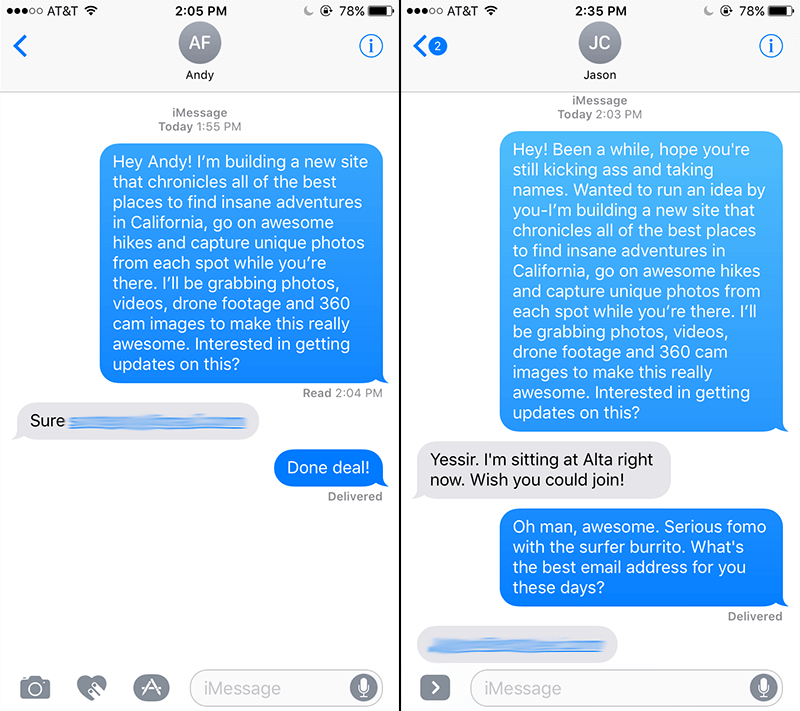
Working this process for just 1 week netted me 47 email subscribers for my early feedback group. Eventually, you could scale up this kind of outreach by employing one of the best CRMs for small business, but at this stage, that’s overkill.
Now, it’s your turn.
Begin by working your way down this list:
- Friends & family
- Co-workers
- Former co-workers
- Other professionals you’ve worked with
- Classmates or former classmates from school
- Teachers or professors you’ve had
- Fellow members in clubs, societies, groups or meetup networks you’re in
Scroll through your recent text messages.
Browse through your last couple hundred personal emails.
Head into your Facebook friend list, LinkedIn connection list and check out your Twitter followers.
Look for people you know, who you think may have an interest in what you’re building.
Then, out of the people who express interest in your idea, ask them if there’s anyone else they know who comes to mind—that might be excited about what you’re building. Double down and get more qualified referrals so that you can keep having conversations with your target audience.
I personally recommend tracking this process rigorously so that you can see the growth of your community and keep their contact information all in one (free) place. Enter: Google Sheets.
Each time I came across someone from my text messages, emails, and Facebook friend list who I thought could be right for checking out my site idea, I added them to a Google Sheet so that I could easily keep track of all my leads.
Here’s a snapshot of my tracking sheet (and here’s a template you can grab for free):
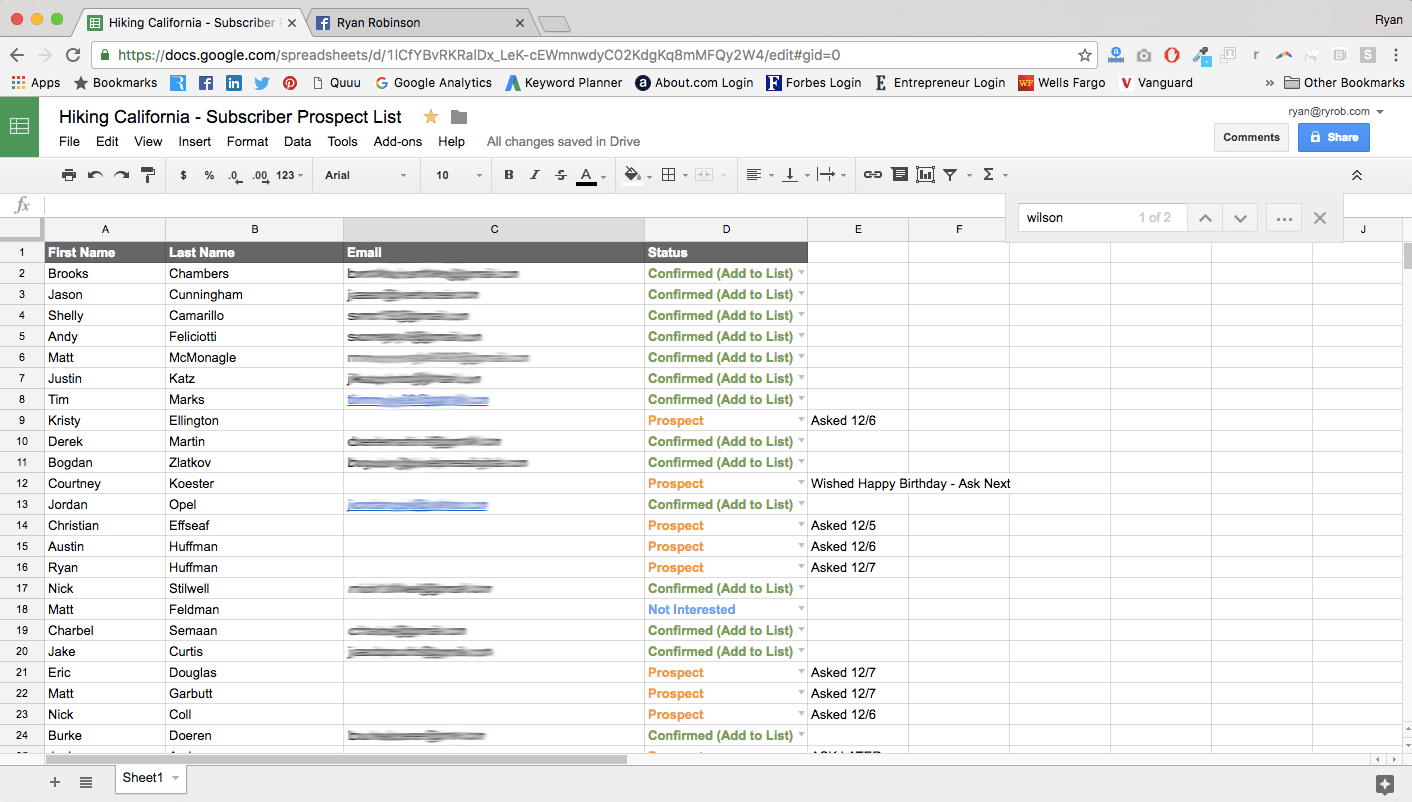
I stopped after getting to 100 potential people I could ask to join my early feedback group.
Expanding your early feedback group beyond your personal network.
With my personal challenge to validate a business idea, I didn’t need to take it this far. I was able to track down enough people interested in hiking in California that I personally knew by combing through my text messages, personal emails and Facebook friend list.
However, if you don’t have the right personal network for your project or you don’t feel comfortable starting with those whom are closest to you, there are still TONS of ways to manually build an engaged early feedback community.
Enter: Online groups and communities.
Now, when it comes to actually starting a conversation in these groups without coming across as spammy or too self-interested, keep in mind exactly what your goal is at this stage: to have conversations with your target audience. Nothing more—we’re not selling anything to anyone yet.
You’re going to best achieve this goal of having great conversations by posing a very open-ended, genuine question to the group without asking people to visit a website, fill out a form or complete any action other than replying with comments in the beginning. Keep it simple.
Here’s a copy/paste script inspired by one of my mentors, Ramit Sethi, that you can use to post in online communities and start meaningful conversations with members:
“Hey guys, I’m thinking of [starting a website, creating an app, building a product] around [topic area]. When you talk to your friends about it, what do you say? What do you think is the biggest problem around [topic area]?
Here’s this posting tactic live in action with one of my TLF students, DJ who was able to quickly generate 25+ subscribers for his early feedback group by posting a variation of this in 10 Facebook Groups:
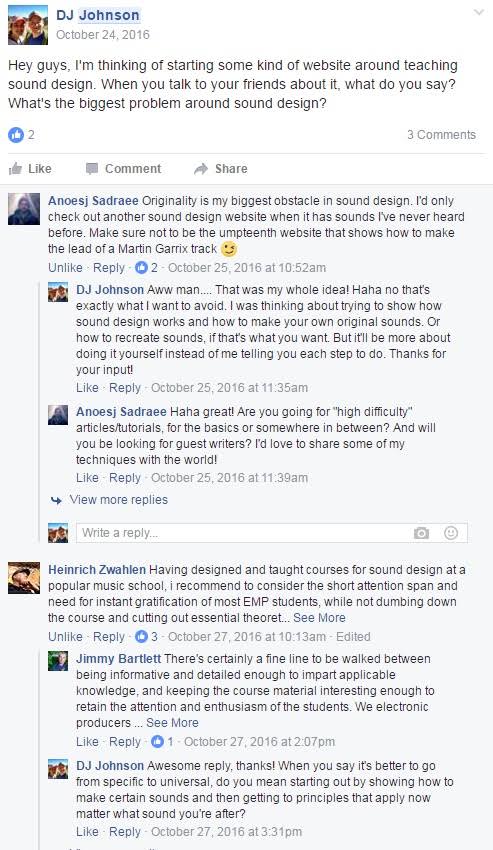
Depending upon how active the group is, you can get anywhere from zero to dozens of comments with thoughtful replies to your question.
Once a few people start responding to your post, nurture those conversations, keep them going, stir up a debate, share your thoughts on the subject matter.
After the post begins to lose a little momentum, send a personalized (private) message to the people who seemed most engaged in the conversation—asking them if they’d like to get updates on your project. If they’re up for it (some will be, some won’t be), ask them for their best email address so you can keep them in the loop and ask a couple more questions.
Replicate this process until you’ve built up an early feedback group of ideally, at least 25 – 50 people so that you’ll begin getting some diversity of opinion within your community.
Finding the right online communities.
From my experience, here are some of the best places and methods for finding potential early feedback group members to give you feedback on what you’re building (even if you don’t know what exactly it’s going to be yet):
Standalone Online Communities.
- AMEX Open Forum for Small Business Owners (broad)
- Angel.co (focus on startup community)
- Inbound.org (focus on email marketing and deciding between tools like ConvertKit vs AWeber vs Mailchimp)
- GrowthHackers (focus on growth & marketing)
- HackerNews (focus on startups and more technical projects/news)
- Quora (broad)
- ProductHunt (focus on startups and tech)
- Bonus: Amazon Reviews (if you’re building a physical product)
Facebook Groups (Topical).
It’s best if you can find topically relevant groups to join—that’s where you’ll know without a doubt that your target audience already exists.
For example, if you’re working on validating a photography-related business idea, you should consider joining groups like Nikon Digital Camera & Photo Enthusiasts (26,000+ members), Nikon D750 Users (27,000+ members) and Nikon UK Photography (13,000+ members). I found these groups by searching for “Nikon” and clicking the ‘Groups’ sort tab at the top of the menu.
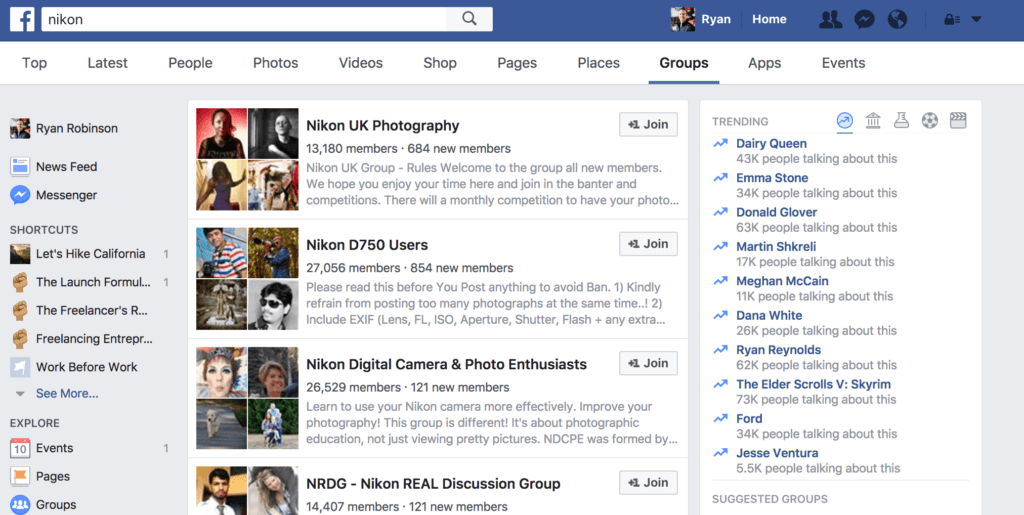
If what you’re building is relevant to anyone with a DSLR camera, you’re sure to find enough people who’d be interested in giving you feedback on your concept from within those groups.
Facebook Groups (Entrepreneurial).
If you aren’t able to find many Facebook Groups with a decent number of members (think 5,000+), it might be a sign that your niche market is too small. However, you can still take to building a feedback community by activating members of entrepreneurial Facebook Groups where members are already conditioned to helping each other with projects like this.
Start with these ones, which I chose specifically because they’re not riddled with spam:
- Freedom Hackers Mastermind (39,000+ members)
- The Smart Passive Income Community (28,000+ members)
- The Joyful Entrepreneur (37,000+ members)
- Heart-centered, soul driven entrepreneurs (16,000+ members)
- Coaches, Authors, Entrepreneurs (13,000+ members)
- Women’s Entrepreneur Network (32,000+ members, women only)
- Super Hero Entrepreneurs (10,000+ members)
LinkedIn Groups (Entrepreneurial).
- On Startups (626,000+ members)
- Future Trends (474,000+ members)
- I ❤ Startups (248,000+ members)
- Entrepreneur’s Network (33,000+ members)
- Band of Entrepreneurs (26,000+ members)
Reddit Sub-Channels.
Keep in mind as you begin posting in communities and forums, that you need to provide value before asking for anything in return—that’s how you build relationships with people and eventually ask them to join your feedback group.
Don’t expect to get stellar results from simply cold emailing a bunch of people you don’t really know, asking them to support your idea.
If you want my dead simple, step-by-step game plan for creating an early feedback community of 25 – 50 subscribers in a matter of days, sign up right here to get updates on my new course, 30 Days to Validate.
Want to find a profitable niche business idea this week? Join my free online course Find a Profitable Business Idea today.
4. Have One-on-One Conversations With Your Target Market.

Once you’ve started to build your small community of early feedback subscribers, you need to keep the conversation going with them. And you can continue building the size of your feedback group throughout this process.
At this stage however, your goal now shifts to focusing more on determining the right mix of highlights, features and value propositions that’ll be most appealing to your target audience.
It’s time to narrow in on what exactly your business is going to be and you’ll solidify this even more in the next stage: Developing a competitive advantage.
Again, since we don’t want to build a solution to a problem that doesn’t really exist, this requires as many one-on-one conversations as possible. Yes, it takes time, but it’ll save you countless hours later by getting your solution right on the first shot.
During my challenge to validate a business idea, a few conversations with my early feedback members naturally transitioned into brainstorming sessions in which my audience started telling me what they wanted.
Check out this text about my hiking site idea, from my friend Michael that lives in Los Angeles, a traditionally very tourist-heavy city.
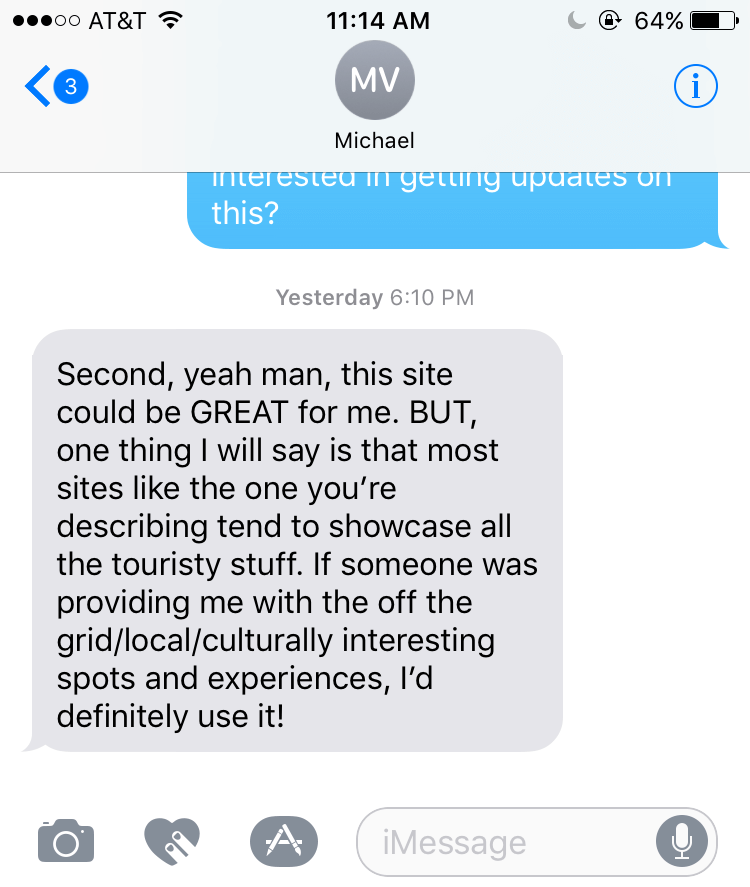
He identified one of his major pain points when it comes to finding good local hikes and adventures to do that aren’t touristy like hiking up to the Hollywood sign. He lives in LA, so he’s already done all that—now he wants “off the grid, local and culturally interesting experiences.”
Two other friends of mine, Bryan Lemos who worked with me at CreativeLive and loves photography, and Alan who’s an active outdoor enthusiast in his own rite over at Love to Camp, now work together and talked about my website idea at lunch after I had texted them both earlier in the day.
They came to me (in a Slack group we have together) with a great idea for a service that they wish existed in the hiking and outdoor market.
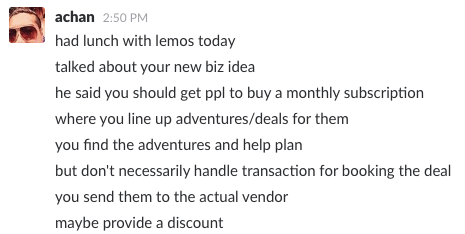
Providing a monthly subscription service where I line up a curated, local adventure and discounted deal for my subscribers to go on once a month. Dead simple and pretty easy for me to implement each month.
Do everything you can to foster this type of idea flow in your conversations. If you listen hard enough, for long enough to your audience, they’re going to tell you exactly what they want.
While you can have these conversations over text, email, Slack or another digital media, nothing beats meeting up in-person for a quick coffee or picking up the phone for 15min to get more meaningful feedback from your target audience.
Here are a few of the top questions you should be asking your target market, with the goal of learning more about their motivations and needs as it pertains to your business idea:
- What are you most looking to achieve (as it pertains to your topic area)?
- What are some of the current solutions you’re using, or have used in the past?
- What frustrates you most about current solutions out there?
- What features would you most like to see (as it pertains to your topic area)?
- Do you have any fears (as it pertains to your topic area) holding you back?
- Would you be willing to pay for a solution that does XYZ for you?
I recommend adding a few additional columns to the Google Sheet you already made for keeping track of your feedback group, so that you can add notes with their answers to these key questions.
By this point in my challenge to validate a business idea, I was starting to get a more clear picture of what exactly my audience wanted from me in the California hiking space.
After thinking more about the two ideas I got from my feedback group—a monthly adventure planning service or a guide to the most under-rated, off-the-grid hikes and adventures in California—and running them by a couple others, I got more votes for the off-the-grid hiking guide.
Once you’ve been able to collect this depth of feedback from at least 10 – 15 people in your early feedback group, it’s time to really formulate your competitive advantage and solidify (at least for now) what you’re business is going to represent.
I pushed forward with the tentative plan of creating the off-the-grid hiking guide.
Now it was time to figure out how to make it significantly more unique, useful and better than existing hiking guides.
5. Develop a Competitive Advantage.
By this stage of validating your business idea, you’ve had a number of meaningful conversations with your target audience and you’ve built a small list of people who are interested in getting updates on your upcoming solution—based on the simple elevator pitch you’ve sent them so far.

Now it’s time to expand a bit on that elevator pitch and pull some more insights out of the feedback you’ve been gathering from your conversations with the people in your community.
All with the purpose of developing a competitive advantage that’ll make your upcoming solution uniquely valuable to your audience. The worst thing you can do is rush to market with an identical solution to what’s already out there.
A competitive advantage is defined as your unique advantage that allows you as a business to generate greater sales or margins, and/or acquire & retain more customers than competitors.
In short, it’s what makes your business, your business.
Your competitive advantage can come in many different forms, including:
- Your cost structure
- Product offering
- Distribution network
- Customer support
- Your own personal skill set (like being able to tell great stories)
- Your experience
- Industry knowledge
- Strategic relationships
- A powerful personal brand
- Large and engaged audience you’ve built
The strength of your competitive advantage will greatly affect your early results in validating your business idea.
With my challenge to validate a business idea in the California hiking space, my competitive advantage for my upcoming website (that didn’t yet exist, mind you), was that I’d be delivering content in a new medium (VR/360°), with a level of quality and depth that was unmatched in an industry full of web 1.0 style websites with stock photos and short descriptions.
To land on the competitive advantage(s) for your side hustle idea, start by carefully combing through all of the feedback emails, conversation notes and ideas you’ve recorded from your target audience conversations so far.
Look for commonalities, trends, surprising insights and particularly interesting ideas that catch your eye. Highlight them as potential value propositions to come back to for developing your competitive advantage.
6. Grow Your Email List.

Despite what many profess, growing your email list (further) is actually an optional step in the process of validating a business idea.
Here’s why: If you’ve already manually built an email list of 100 or more subscribers through the various audience building tactics we covered in #3 (which you could definitely do given enough time and effort), you likely already have enough people to validate your idea with.
Sure, more of the right subscribers would help increase your chances of successfully validating your business idea, but anything more than ~100 or so, is bonus points for the sake of this validation test.
Revisiting our initial goal for setting out to validate a business idea in the first place, it’s to give us reasonable confidence in the future success of our solution.
Put simply, you don’t need more than 100 subscribers to validate an idea and get at least 10 paying customers.
If you’re sitting below that magic number of 100 subscribers or you feel strongly about needing to acquire a larger audience before building a proof of concept, let’s get into growing your email list beyond where it’s at right now.
I’ve written about a lot of list building tactics that have worked well for me over the years, but here are a few of my favorites for quickly growing your email list beyond the limitations of manual outreach.
1. Guest Posting (to Grow Your List and Validate Your Business Idea).
While guest blogging is significantly more effective in the long run once you have time to make a website or of your own already (could be a good reason to learn how to start a blog today and eventually learn how to make money blogging), recent blogging statistics suggest it’s not as necessary in the context of validating an idea quickly.
All you need is a very basic “landing page” that gives you the opportunity to capture the name and email address of any readers who are interested in learning more about what you’re planning on building—based on a brief description written on your landing page. This landing page will be a foundation for the proof of concept you’ll be building in the next step anyway.
Within your guest post that’s topically relevant to what you’re planning on creating, you’ll tastefully link back to your landing page so that readers can click through to learn more and sign up for updates.
Here’s an example of a guest post I recently wrote for Lifehacker, one for Forbes, one on Inc, and another on CreativeLive’s blog. You’ll notice that I always make sure to include at least 1 link back to a specific post, landing page or project I’m seeking to promote (or validate) within the first few paragraphs of the guest post to make sure I’m maximizing my chances of driving back readers who are interested in signing up to learn more. This is a smart blog SEO strategy to incorporate from the start.
Again, you do not have to go through the process of choosing the best website builder and getting a site online before guest posting. Your landing page can be as simple as you allow it to be. I’ve created basic landing pages from (free) Google Forms, (free) Google Docs, (free) Gumroad sales pages and through free trials with a more robust blogging tools like Unbounce or Instapage.
What’s most important about the basic landing page you build, is that you’re able to (1) write a brief description of your upcoming solution and (2) ask readers to sign up with their email address for updates. You can collect their email addresses by using a Google Form, which will store them neatly in a Google Sheet you’ll be able to refer back to later.
Here’s an example of a guest post I wrote for the Desprenuer blog (right here), a popular website that gives designers the tools they need to grow their businesses.
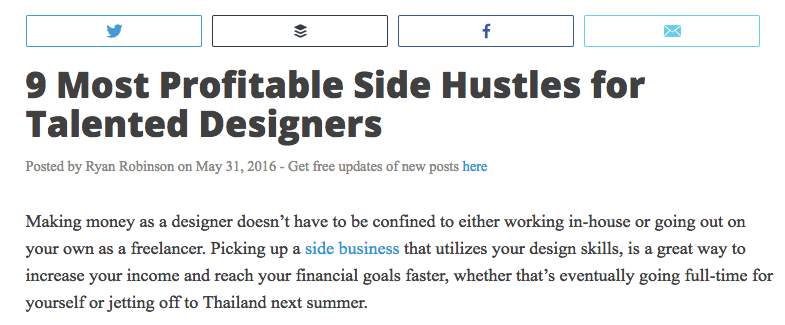
You’ll see that I included a link back to the post I wanted to promote on my own blog (about side businesses), within the first paragraph of this guest post. This guest post took me about 30-45 minutes to write and was a shortened derivative of the original post I linked to in that intro paragraph up top.
I know, I know… you don’t have a ton of blog content of your own, so you “can’t” do this, right?
Not quite. If you think you don’t have the content for writing a guest post, you’re mistaken. Take all the bits and pieces of conversations you’ve already been having with your target market, identify the value propositions they’ve been resonating with most and start expanding on each of those points.
Now, let’s talk about pitching a guest post & identifying the right destinations and people to pitch to.
All it took to land this guest post on the Despreneur blog, which drove back a couple hundred visitors to my site, was a quick email to the editor, Tomas Laurinavicius. I mentioned a recent podcast episode he recorded with another entrepreneur, which showed I took an interest in what he’s doing and established relevancy by noting that I’m also a Forbes contributor. Side note—if you’re considering starting a podcast yourself, check out my picks for the best podcast hosting to get your show online.
Then I pitched him on writing a guest post:
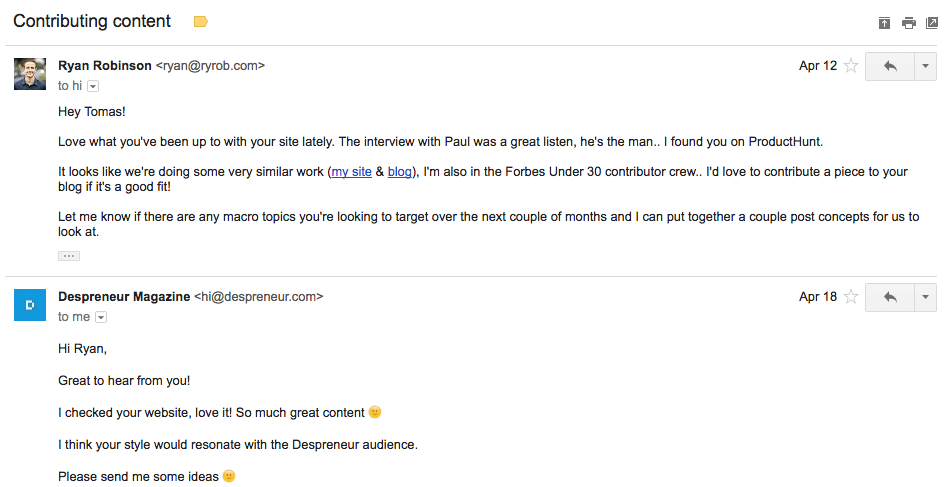
This worked particularly well for me because the content I referenced on my blog was already performing well and Tomas also had some mutual connections with me (via Forbes), so there were fewer barriers between us.
But you probably don’t have a strong personal brand or contributorships on major publications… sure, that’ll make this more difficult. However, my very first guest post was landed on Buffer’s blog (1 million+ monthly readers) back in 2015 long before I had any semblance of an audience or credibility. I cold emailed one of the writers on their team with a few strong topic ideas I knew she’d be interested in, then she asked to see a draft of one and the rest is history.
Success with pitching guest posts begins with choosing realistic targets, but never doubt the power of asking for what you want—tons of other people have also been able to land high value guest posts without any “street cred” of their own yet.
Now let’s dive deeper into my 5 step process for cold pitching guest posts.
Step 1: Create a landing page (or blog post/proof of concept).
Nearly every blog post idea I publish to my site is treated as a proof of concept for a potential course topic I can cover in the future. I choose to use blog posts for all of my proof of concepts because that’s what I’m good at and I can do it quickly. For your purposes, this landing page can be in the form of a simple blog post (just be sure to learn how to write a headline that’ll appeal to your audience), sales page, product description, video or otherwise—this is the destination that’ll serve as home base for when you’re ready to go out and pitch guest posts.
Step 2: Build a list of publications, brand and blogs.
Once I publish a post to my blog, I’ll create a shortlist of 10-20 different publications, blogs and brands that I think I can realistically land a guest post with—on a topic closely related to my landing page back on my own website. I’ll vet these websites and make sure it looks like they accept content on my topic and that they have engaged readers for the subject matter, otherwise it’s not the best utilization of my time. Once I have my list, I’ll rank everyone on it based on how much traffic I can drive to my website from a guest post (an estimate).
Step 3: Create outlines of derivative works from the original post.
Next, I’ll break down the sections of my original post and start outlining what a more detailed post could look like—expanding upon each of these sections from my original. For example, from my post on the 10 Steps to Starting a Business While Working Full-Time, I could choose #2 on the list (Inventory Your Strengths and Interests) and outline a more detailed post that expands upon actionable strategies for finding your strengths and interests. Now, I’ll start to pair up these new post outlines with the target websites I want to get a guest post published on.
Step 4: Find the right point of contact at my target websites.
This is key. You need to pitch a real person and make sure it’s the right person. That’s someone who (1) cares and (2) can do something about your guest post idea. For that reason, I always look to target a marketer, writer, editor or blog manager at the destination I’m looking to secure a guest post on—these people will all be on the same page when it comes to the constant need for solid content and they’ll either have or know the people with the decision-making power to grant a guest post.
Step 5: Reach out with a value-driven approach, then pitch.
Most of the time before pitching someone on a guest post, I’ll first go back to my original landing page or post on my blog and add in a relevant link to a piece of content on the blog of the target destination I’m trying to get a guest post on. That way, when I reach out to the marketer, writer or editor, I can keep the message related to just my mention of them in the post on my blog—providing value first.
I’ll ask them to give it a quick look to make sure I’m citing them properly and linking to the best possible destination for them; two things they’ll care about and it’s not a big ask. That gets them to my website where they can see what the post is about and a bit about me. Then once they respond, I’ll pitch them on the guest post topic that I believe to be most relevant to their readers.
It’s a lot of work and you definitely want to spend some time promoting the content and making sure your guest post does well. But by building relationships that are founded on delivering value before asking for anything in return, you’re going to plant the seeds for a relationship that has the potential to grow and evolve over time.
This strategy will also set you apart from the 50 other people that email in every day asking to guest post.
If you don’t have a website up yet, you obviously can’t use this exact approach verbatim. Instead, you’ll have to compensate by reaching out to more people. It’s a numbers game, but I promise you can make it happen. If you want help strategizing, shoot me an email at ryan@ryrob.com and I’m happy to help.
2. Facebook Ads (to Grow Your List and Validate Your Business Idea).
If you have a little budget ($50 – $200) for testing paid traffic, Facebook Ads (especially if you can produce high quality Facebook video Ads) are going to be your biggest bang for the buck, by far. With that budget range, you can generally drive a couple hundred extremely targeted visitors to your landing page and see how they react to your proof of concept.
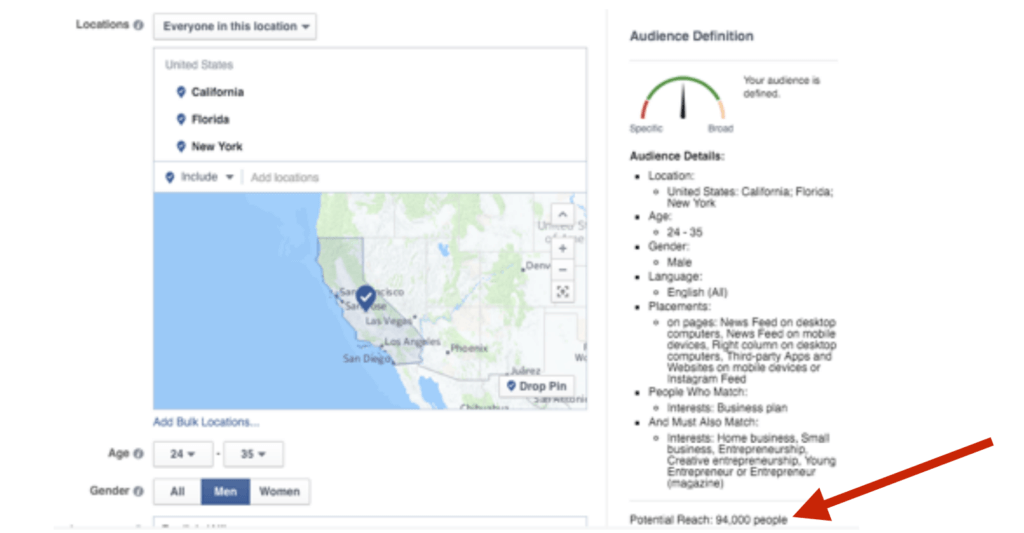
For one of my past businesses, Case Escape, we were able to validate the concept of offering our Startup Kits—a business in a box style package that helped people start their own phone case business—by spending around $100 on Facebook Ads for a week to generate leads which led to phone conversations and making our first $5,700 sale.
Both AdEspresso and Hootsuite have amazing guides to getting started with Facebook Ads that I highly recommend. Facebook has their own deep dive on ad targeting as well.
3. Giveaways (to Grow Your List and Validate Your Business Idea).
In my experience, giveaways are a very mixed bag. Sometimes they work very well and give you a ton of qualified leads, but other times you’re left with a worthless list of people who signed up solely to win something cool.
My advice: Keep your giveaway item as closely related to your upcoming solution as possible (and keep your costs as low as possible). Spending meaningful amounts of money before you have a clear path to making it back is dangerous.
I recommend hitting the pavement to visit local stores, picking up the phone and doing what you can to try and broker discounts on your giveaway items before purchasing—in exchange for some advertising exposure to your audience.
Giveaways only make this list because they’re a potentially viral marketing tactic that’s worked well for me in the past. I used one during my challenge to validate a business idea and generated 565 email subscribers in just 6 days for a GoPro and Osprey pack giveaway thanks to the built-in viral sharing that the KingSumo Giveaways plugin has.
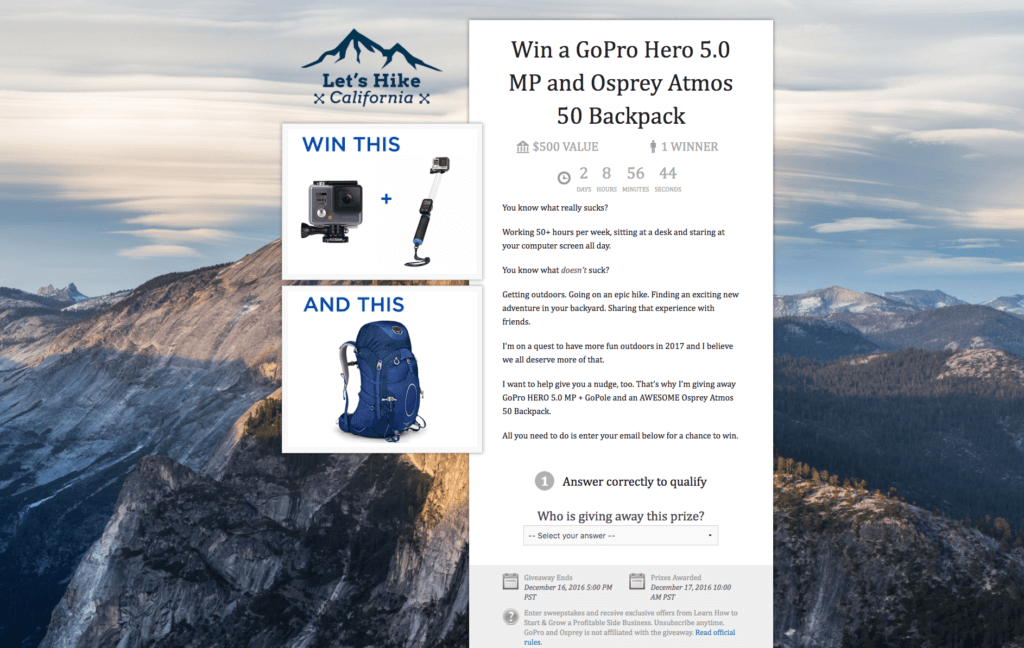
The idea behind a giveaway is simple: Run a sweepstakes and give away an awesome, relevant product or service for free in exchange for asking entrants to sign up for your email list.
Incentivize them to share the giveaway on the backend after they sign up by offering a few “extra” entries into the giveaway for every friend they refer to my giveaway, which KingSumo Giveaways does very well.
Starting with just 47 people in my early feedback group, I was able to grow that number to 565 in just 6 days thanks to their sharing. That means they referred an average of 12 friends each.
For the specific copy/paste email templates I used to kick my giveaway off with a bang and help make sure it succeeded, jump down to my Update #2 of the validation challenge.
Now, once you’ve built your email list to a size you’re comfortable with (I recommend ~100 subscribers), it’s time to start building your proof of concept.
7. Build a Proof of Concept.
Now you have a small (but growing) audience. You know the specific offering you want to validate your business idea with. In my case with this validation challenge, that was an off-the-grid hiking guide to the most under-appreciated adventure destinations in California—documented in VR/360°, drone footage and video.
But I didn’t have the time to go out and shoot all that content, get it edited and HOPE people paid me for it. That’d take months and probably a good amount of money.

Instead of pausing here to invest weeks or months into building your course, writing your book, developing an app or creating a complex website to highlight your freelance skills in order to land the best work from home jobs or otherwise remote gigs, we still want to make sure there’s a (paying) demand for what you plan on building—before you actually go out and build it.
That’s where building a simple proof of concept comes into play.
A proof of concept is a realization of your method or idea that demonstrates its feasibility.
Well constructed proof of concepts are designed to achieve these 3 things:
1. Verify that your solution solves the problem you’re attempting to address.
2. Confirm that your solution is valued by your future customers.
3. Determine whether or not people will pay for your solution.
Setting your proof of concept goal.
Once you have a more clear picture of what your specific product or service offering is going to be (based on your target market conversations and using a smart keyword research tool) and you’ve developed a competitive advantage that’s going to make your offering unique in some way, it’s time to set a goal for what you want your proof of concept to achieve.
Only that which is properly tracked and measured, improves.
Your proof of concept goal will be unique to your business and it needs to give you relative confidence in the future of the solution you’re building.
There’s no definitive, across the board success metric for all proof of concepts, but I always recommend setting a proof of concept goal of generating a specific amount of revenue from a pre-defined number of paying customers.
Here are a few popular examples of proof of concept goals:
- 10 pre-orders for your upcoming product or service
- $100 in affiliate commissions generated
- 100 listeners on your first podcast episode
- Getting a book proposal accepted by a publisher
- 100 waiting list subscribers
- Fully funding a Kickstarter campaign
With my challenge to validate a business idea in the California hiking space, I set my proof of concept goal at 10 pre-orders of the hiking guide I wanted to create. If I could get 10 people to pay me for a book that doesn’t yet exist, that’d give me enough confidence to go out and actually shoot the content & create the book.
Now that I had the goal I wanted to achieve—10 book pre-sales, it was time to create a (simple) preview of what that would be, so I could start pitching it and asking my subscribers to buy.
Here are a few examples of the many different forms a proof of concepts can come in:
- Google Doc (like the one I created to validate my hiking guide)
- Blog post (like the one I wrote to validate my first course idea)
- Explainer video
- Portfolio of your existing work (like this free one on Contently)
- Hand-built prototype (like my $100 iStash prototypes)
- Simple product sales page or website
- A scaled down product or tool (like these no-code prototypes you can build in a weekend)
- Rough demonstration of your software solution
- Email or email newsletter (like how ProductHunt started)
- Self-published book
- Facebook or Slack group (like #Investing, a group created by a reader)
So, going back to leveraging my core skills (which we covered the importance of in #2 of this post), I took a couple of hours and wrote out a simple Google Doc Proof of Concept that was just a few pages long, to serve as my proof of concept for this hiking guide idea.
You can check it out and grab the template for it right here.
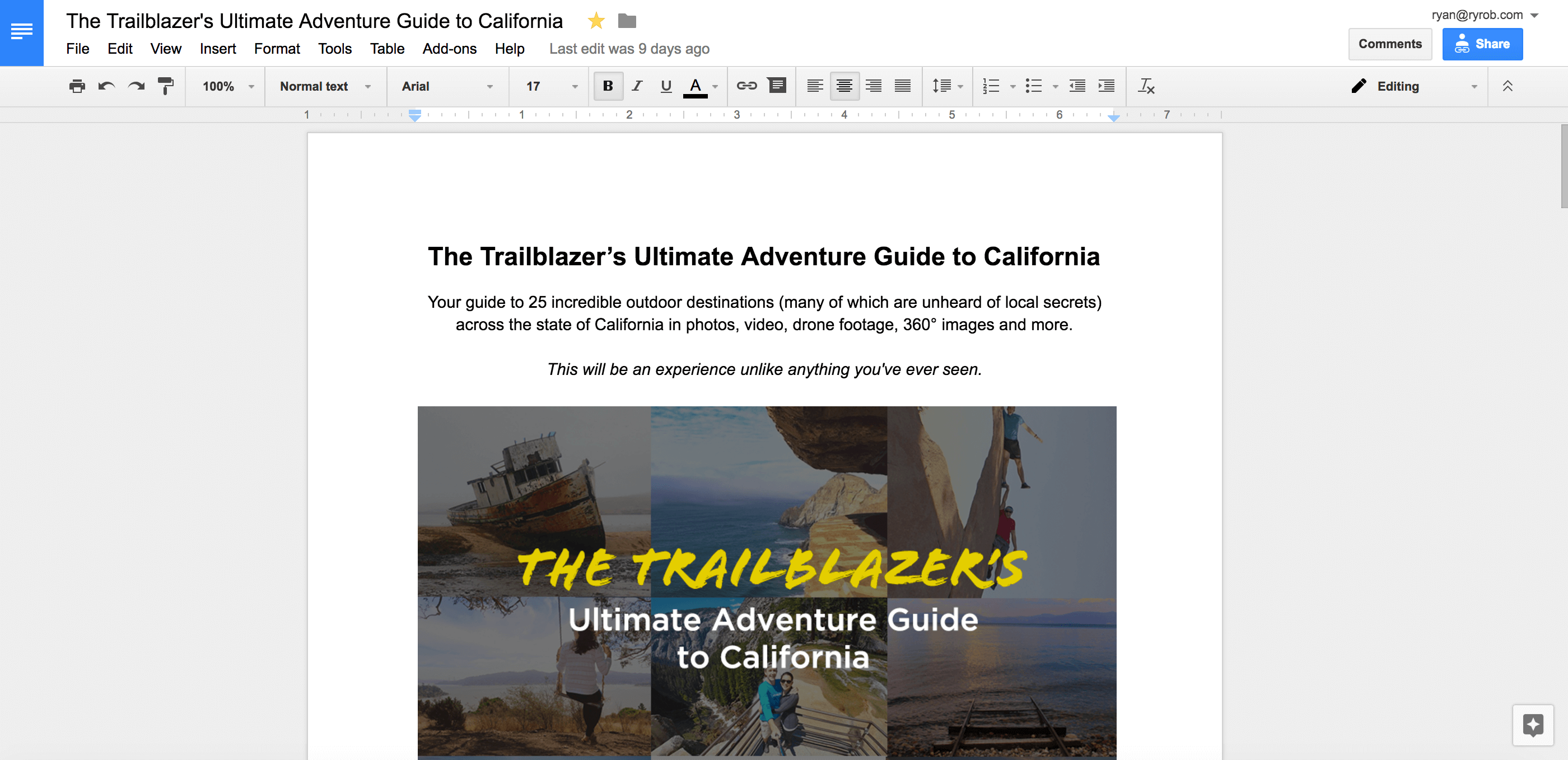
I kept it ridiculously simple (721 words). I whipped up a quick header image and just wrote what I wanted the guide to be—while focusing on how it would benefit readers.
It wasn’t perfect, it didn’t highlight absolutely everything it could have, but I ran it by one of my friends (a subscriber) and we came to the consensus that it was good enough to get the job done and help me secure pre-orders.
Note that at the end of the proof of concept page, I wanted to include a link to where people could immediately go and pre-order the guide. Giving readers the option to go and buy the guide without me first directly asking them to purchase would tell me a lot about how excited they are for this guide.
Now it was time to pre-launch it to my subscribers and see how it’d go.
Want to find a profitable niche business idea this week? Join my free online course Find a Profitable Business Idea today.
8. Launch and Get Pre-Orders From Your Email List.
You’ll need a secure way to accept payments from your subscribers before asking them to buy.
That could be as simple as asking them to PayPal you the dollar amount, using a free card reader from Square to accept CC payment or setting up a simple product page on a platform like Gumroad (I chose this option for my validation challenge).
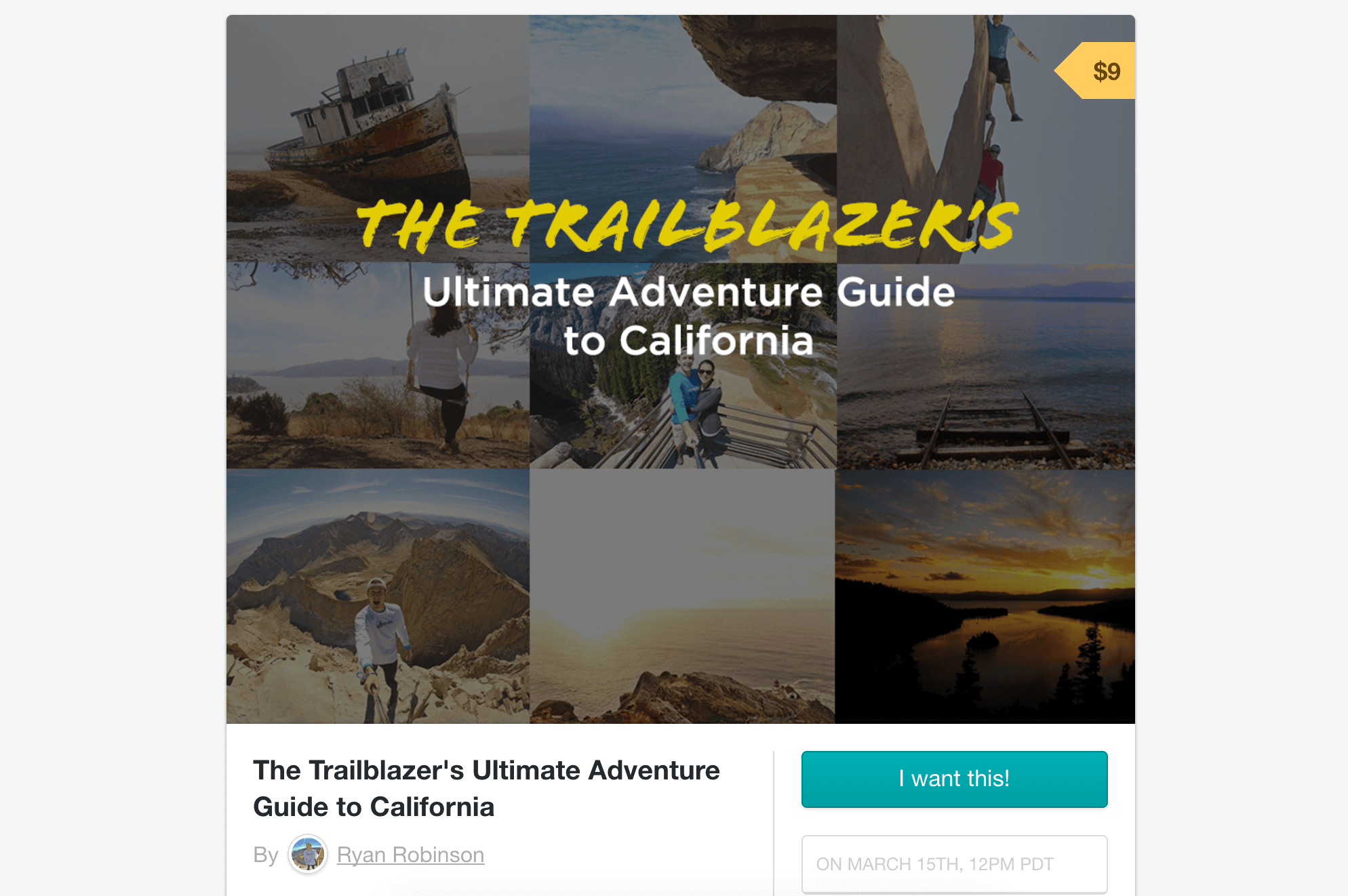
I chose Gumroad because they have the quickest setup time in my experience, and I knew they offered the option to pre-sell products without charging the customer’s credit card until the guide is actually finished—something I really wanted to highlight to my potential customers so they’d know they’re not getting scammed.
Even if you’re looking to sell handmade goods and eventually plan to sell them on Etsy, choosing to first use a simple pre-ordering flow through Gumroad is going to be much quicker and less overwhelming in the short term.
Choosing a realistic price point.
Next, you’ll need to choose a realistic price point for your offering—a price point that helps you achieve your proof of concept goal.
I wasn’t worried about the dollar amount I earned from pre-sales of the guide, since my goal at this stage is to validate my business idea—not make thousands from it this week. This is something that so many aspiring entrepreneurs neglect to see the importance of, which often leads to failure, loss of motivation and disinterest in an otherwise great idea.
You have to use the tools at your disposal, especially as you’re just getting started. One of those tools is choosing to offer an otherwise very low price point for your product or service when you go out to pre-sell it to early subscribers.
That discount is in exchange for them giving a vote of confidence and waiting while you actually produce the solution—in turn, you get to prove that there is a paying market for your product before investing in it.
As a starting point for pricing my digital guide, I decided to take a look around and see exactly what others were charging for similar hiking-related guides and see if I could price myself in the same ballpark.
I took a few minutes to do a little research and found that Lonely Planet, an outdoor reviews site amongst many other things sells their digital eBook destination guides for $8.99 on average.
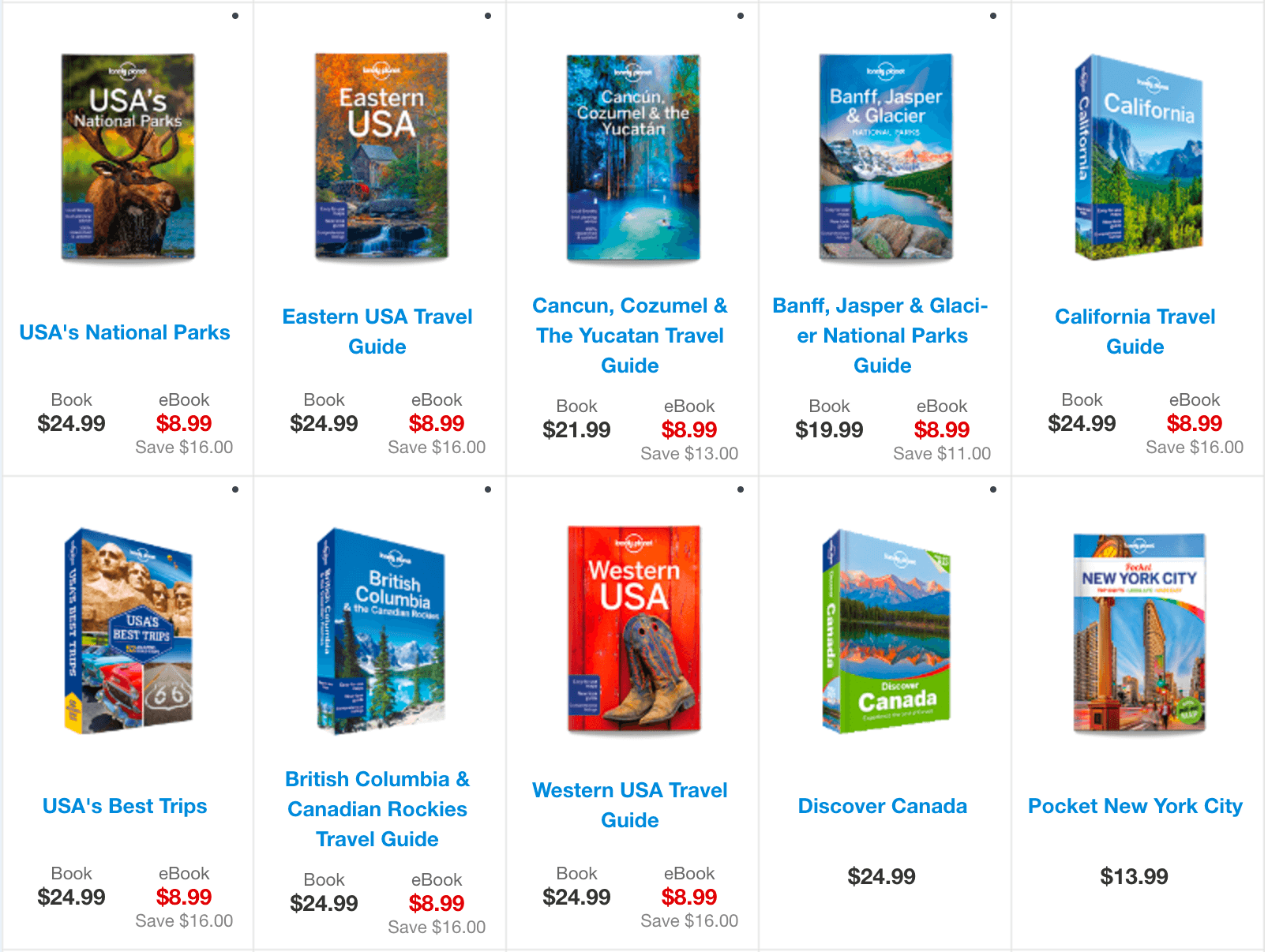
Despite knowing that my guide would explore California’s destinations in new content mediums, with greater depth and more careful curation, I decided to (again) keep things simple and price the pre-sale of my guide right at $9 since that’s what many consumers are currently conditioned to for a guide of this type… if not free even.
I made it clear on the product page that the price point would be higher ($29) for the guide once it’s finished, to increase the urgency for those who are interested, to pick it up right now.
Now that I had my proof of concept Google Doc and a live product page ready to go, it was time to try and drive in some sales.
Getting your first sales.
Your first sales need to come from manual, individual conversations with your subscribers. You can’t mass email a link to your proof of concept or sales page and expect people to immediately buy (or even understand the value in buying).
Before emailing my list of 565 subscribers I had acquired from my giveaway, I wanted to go back to the 4 friends I had consulted about which product ideas sounded more interesting. I texted them a customized variation of this message—skipping the proof of concept Google Doc and linking them straight to the purchase page to see how they’d respond:
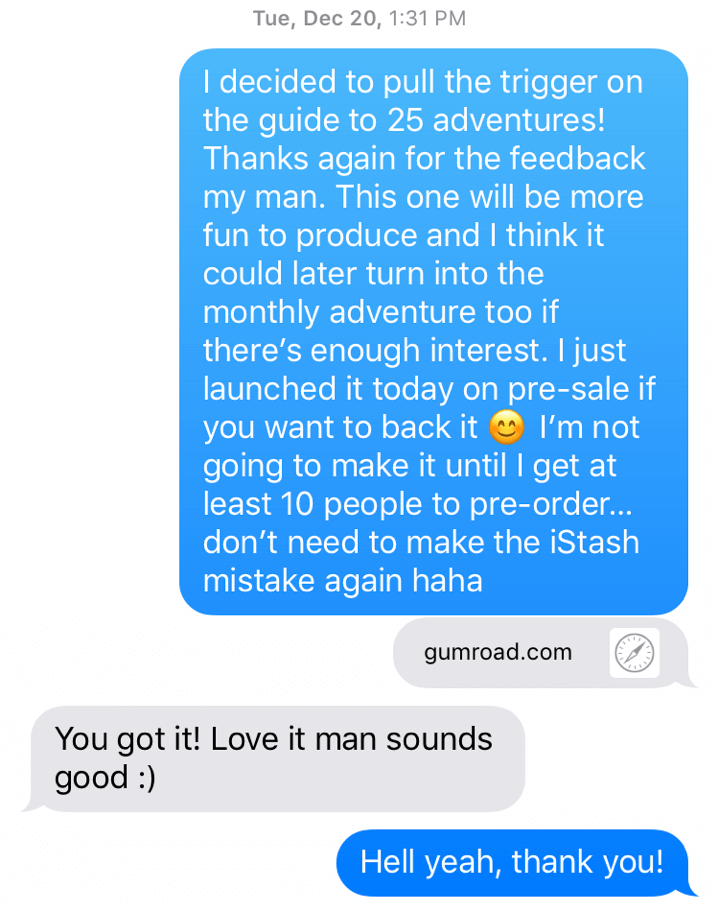
1 of them bought.
That gave me a quick vote of confidence.
Next, I revisited ~15 the individual email conversations I still had going with the friends & acquaintances who’d joined my early feedback group. I was still familiarizing myself with selling this guide & learning what was most attractive about it.
Since some of these people I’d reaching out to via email weren’t my closest friends, I didn’t want to immediately ask them to directly buy my guide. I wanted to ask for their opinion and gather their feedback on my proof of concept document first.
So, I turned to using my Feedback to Pre-Order Sequence (you can download the copy/paste email scripts right here) I use to pre-launch courses and other products. It’s another extremely useful strategy & toolset we’ll be covering in my new course, 30 Days to Validate.
Here’s how the Feedback to Pre-Order Sequence works:
Step 1: Ask the person to check out your proof of concept and complete a short survey leaving feedback about it.
Step 2: Genuinely answer their questions (from the feedback survey) and ask them if they’d be confident enough in your [product] to pre-order it at a discount today.
That’s it. So simple it’s ridiculous.
Important: In the survey, it’s incredibly important to ask the yes or no question of whether or not they’d buy this [product]. You can prioritize your time on the people who pre-qualify themselves as being interested in buying.
Meet their objections head on and be honest about whether or not you think your solution will be a good fit for them based on the feedback they’re giving you.
Now, here’s my Feedback to Pre-Order Sequence in action with a former co-worker and photographer, Matt who’s been giving me feedback on my California hiking guide project for the past couple of weeks.
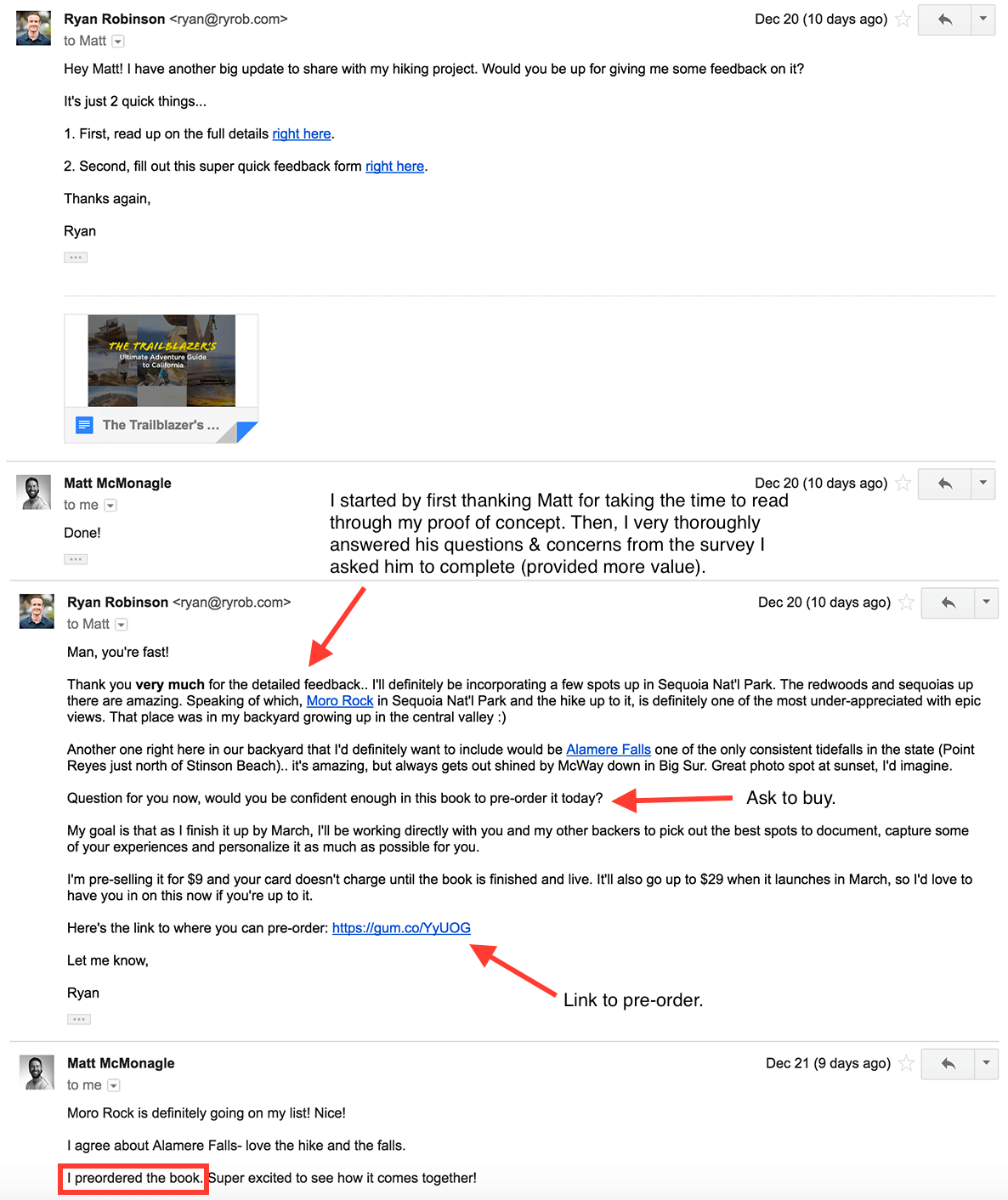
(You can click right here to view the zoomed in email and read easily)
That now brought me up to 2 pre-orders.
So, I continued to replicate this approach manually with more of my most engaged early feedback subscribers.
The pre-sales continued to climb throughout the next couple of days.
Here’s another example conversation I had with a former co-worker, Brooks who’s relatively new to California but loves finding cool new hikes off the beaten path in the bay area.
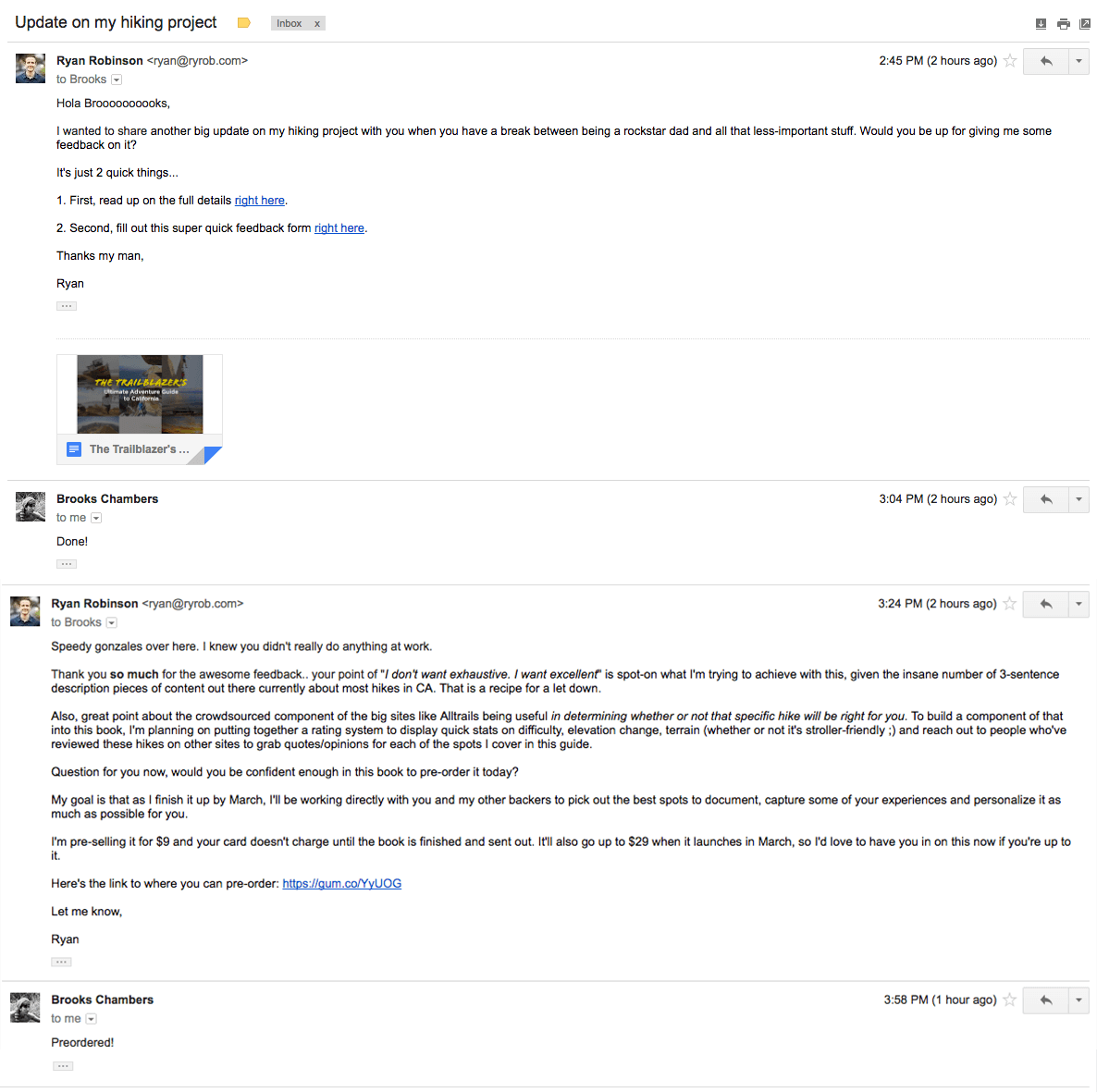
(You can click right here to view the zoomed in email and read easily)
Did it take time having these 1-on-1 conversations with more than a dozen people? Definitely.
But with every conversation and feedback form that rolled in, I learned something new about both my audience and what my product represented to them. I was getting a step closer to validating this business idea each day.
A lot of people really resonated with the idea of getting curated adventure recommendations that aren’t mainstream, touristy and crowded—that fueled my motivation every time I got positive feedback.
This experience also gave me a more clear sense of how to sell this guide more effectively moving forward—I could see first-hand which selling points were getting the most thumbs up.
By the end of the last week of my challenge to validate a business idea, I was sitting at 12 pre-sales totaling $108 in revenue.
I achieved my validation goal (10 or more pre-sales).
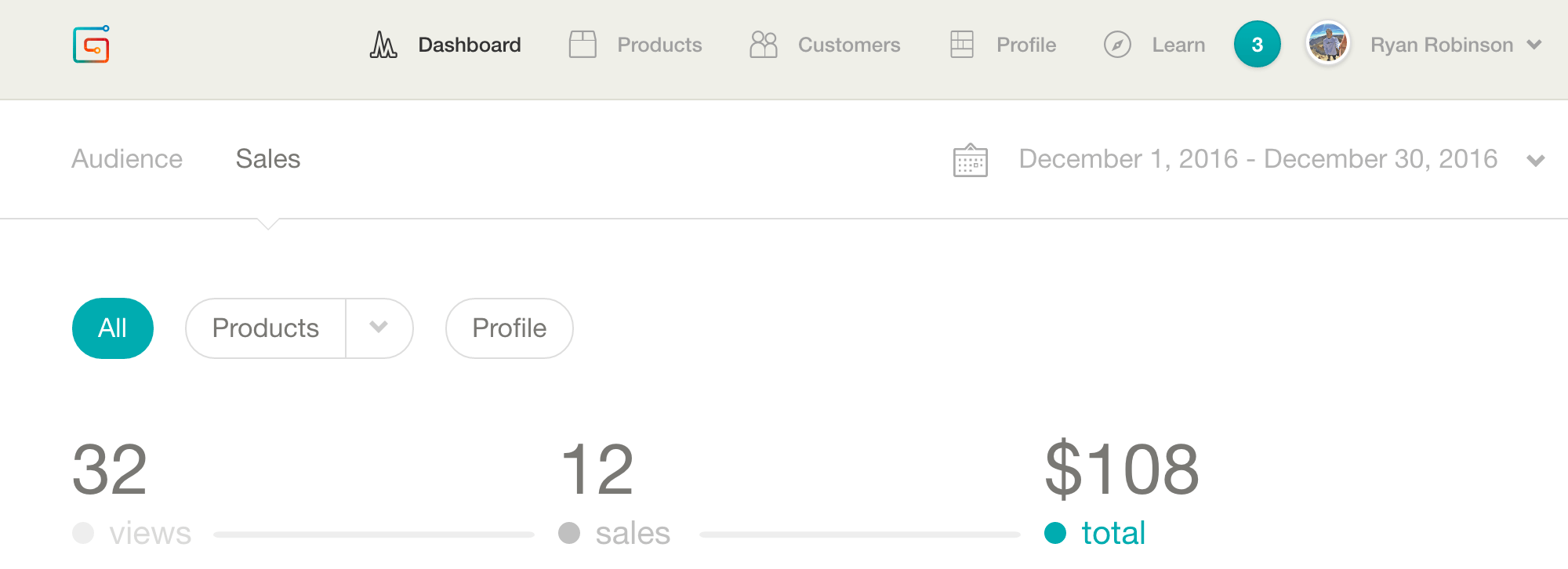
I validated that business idea.
Could I have kept going and made several hundred more over the next few days by keeping the one-on-one conversations going or sending an email broadcast to all my subscribers once I had my pitch down?
Probably, but I already achieved my validation goal so I wanted to move forward.
What comes next after you complete your pre-launch sequence?
Keep going. Continue building with even more confidence. Engage more with your subscribers and customers to make sure you’re still providing them with something they want.
Want to find a profitable niche business idea this week? Join my free online course Find a Profitable Business Idea today.
9. Continue Building and Tweaking With Feedback.
If you’ve successfully validated your business idea, the real work has just begun—and that’s exciting as hell.

As responses roll in from your pre-launch pitches, you’ll undoubtedly collect valuable feedback that’ll help you make your solution even more effective for your audience, if you listen carefully.
If your pre-launch didn’t go as planned and your validation test failed, don’t give up.
This is just the first of many setbacks that’ll be coming your way as an entrepreneur. Failure is a natural (necessary) part of the journey. It’s what you decide to do next that defines you. Trust me, I’ve been there many times.
It’s time to digest all of the feedback you’ve gotten and determine some possible causes of why your validation test failed.
Some common reasons validation tests fail are:
- Pitching to the wrong audience
- Not getting in front of a large enough audience
- Not creating enough perceived value in your proof of concept
- Not incorporating or highlighting the right value propositions
- Pricing the pre-order of your solution above what your audience will pay
- Existing solutions on the market are already “good enough”
So, what comes next for you?
Do you want to validate a business idea of your own in the next 30 days?
I’m talking about finding a profitable business idea. Quickly building an email list of real potential customers. Generating revenue in a matter of days. Creating the foundation for what could quickly grow into a profitable business that solves problems you care about.
I did everything in my challenge to validate a business idea in less than 30 days with around 5 – 10 hours of work per week, maximum. And that was with a week-long vacation built in.
All of the money I spent validating my business idea (less than $500) was recouped within the same month and I was able to generate $108 in pre-sales of an eBook that doesn’t yet exist, to a handful of my email subscribers… thus validating my business idea.
Sound like something you’d like to do too?
If you’ve been wanting to start a business but don’t know exactly what it should be…
If you haven’t been able to get much traction with the idea you already have…
If you feel like you don’t have the time or money to start a business right now…
If you’re just not sure of how or where to get started and you’re looking for a step-by-step game plan to launch…
I’d like to personally help you.
Would you be into that?
I’m looking for beta testers to help me finish my next course, 30 Days to Validate (and validate a business idea of their own).
I want you to get real results. And if you’re up for it, I’d love to personally help you do this right now.
If you want to beta test my new course, you’ll get the first look at all of the course material, membership in a private Facebook Group with me so I’ll be able to tailor the content specifically to your questions and you’ll get direct access to me for the coming months while you build your business.
Are you ready to do this? Now, here’s the original validation challenge post.
My Step-by-Step Challenge to Validate a Business Idea in 30 Days (With Less Than $500)
Here’s the deal. I want to show you how easy it can be to validate a business idea—any idea—very quickly without spending hardly any money at all.
In celebration of the launch of my flagship course, The Launch Formula (shameless plug), I thought there’d be no better way to demonstrate just how easy it can be to build the foundation for a profitable business if you have the right mindset, blog goals, a real blogging strategy and clear plan of action.
There’s no reason why you can’t start a business today and build a successful foundation in a matter of just a few short weeks…
The Goal.
In just 30 days, I’m going to choose a business idea (comment below what you want me to build), create a proof of concept for that idea, build a list of potential customers, launch a product to them and validate the business idea.
Want to find a profitable niche business idea this week? Join my free online course Find a Profitable Business Idea today.
Kickoff Note: We’ve Chosen the Business Idea.
Dec 2nd: As promised, I’ll be updating this post regularly throughout the month of December. Click right here to jump down and start reading from my Kickoff Note.
Update #1: Elevator Pitch, 47 Email Subscribers, Generating Product Ideas and a Giveaway Idea.
Dec 8th: A lot has happened over the past week. Through manual reach out efforts to friends, old co-workers and acquaintances, I’ve built up a list of 47+ email subscribers (and growing) who are interested in learning more about my website. I’ve got my elevator pitch down, a few ideas for products I can sell from my future website and plans for a giveaway to scale up my list building efforts are in the works. Click right here to jump down and read more starting from Update #1.
Update #2: 305 Email Subscribers, Strategic Connections, Reddit, Launching the Giveaway and Influencer Outreach.
Dec 15th: I still can’t believe everything that’s happened with this project in the last week. The number of email subscribers I’ve generated for this (as of today non-existent) website is now sitting at a whopping 305. Because I’ve been sharing this idea with a lot of friends interested in hiking & photography, a few huge strategic connections with influencers and other well-established hiking-related sites have sprung up. I launched the giveaway, it picked up some momentum on Reddit and I reached out to a handful of photographers who shoot the California outdoors to ask for a share. Click right here to jump down and read more starting from Update #2.
(Final) Update #3: 565 Email Subscribers, Ending the Giveaway, Finding a Product Idea, Building a Proof of Concept, $108 in Book Pre-Sales, Holiday Vacation and a Big New Opportunity.
Dec 30th: MISSION ACCOMPLISHED. The past couple of weeks have been a rollercoaster ride, but I’ve successfully validated this idea. Thanks to my gear giveaway making it onto Reddit’s /r/giveaways, my email subscriber numbers ballooned all the way up to 565. More later on why that’s not necessarily a great thing. I wrapped up the giveaway and shipped the goods to the winner, sold enough stuff on eBay and brokered a high enough rate on the extra freelance writing piece I took on, to more than pay for the giveaway items already. I spoke one-on-one with my audience and used their feedback to find a product idea with the goal of pre-launching to truly validate this business idea. Next, I built a proof of concept, asked for more feedback and generated $108 in pre-sales (so far). With the holidays, I powered down my computer for more than a week (family time is important to me) and this project led to an exciting new opportunity for both you and I, which we cover in the update. Click right here to jump down and read more starting from Update #3.
The Rules.
It wouldn’t be very fair if I just took an idea I’ve secretly been working on behind the scenes for months or used my existing audience & website to boost my early results, so here are the ground rules I’m setting for myself.
1. You Tell Me What to Build. There are 3 topic options to choose from at the bottom of this post, which I selected because I have a genuine interest in them (this is a core principle of starting a meaningful business). Tell me in the comments which topic you want me to build a business around. I want to show you that you can quickly build a business around anything you care about.
2. $500 Limit. Sticking with my lean business building philosophy, I’m going to limit myself to spending no more than $500 on validating this business idea. I’ll be showing you how to build a business without breaking the bank.
3. 30 Days to Validate. I’m going to pick a topic, validate it with an email list of potential customers and launch a product or service to that list by the end of December. It’s that simple. I’m going to show you that you too can do this in 30 days or less while keeping your full-time job.
4. I Can’t Use My Existing Audience. To keep things fair, I’m not allowed to use my existing ryrob.com audience or website traffic to accelerate my early results. I’ll show it’s possible to build an audience in 30 days.
5. 25 Hours/Week Maximum. For this challenge, I’m going to limit myself to treating this like a side business—I’m only allowed to allocate 25 hours per week to validating this business idea. I’m not taking any time off to focus solely on this. The show must go on with my freelance business and course students, so this will be my side business for the month of December. This is also the same amount of hours I was putting into building my freelance business on the side while I still worked at CreativeLive. I’ll show you that it’s possible to build a business around your day job in no more than 30 days.
I’m going to be doing this completely from scratch. Zero traffic. Zero list. Zero existing customers.
…
Do you want to see that? If so, tell me in the comments.
I have 3 topics in mind. All of which I’m genuinely interested in and aren’t around selling my content marketing strategy services (i.e. my existing freelance business).
Topic #1: Hiking in California
Topic #2: Cooking Hacks
Topic #3: Long Distance Running
Which one would you like to see?
Tell me in the comments below.
…
…
Kickoff Note: We’ve Chosen the Business Idea.
Dec 2nd: WOW! After 205+ votes in the comments and well over 400 email replies (holy crap), the winner for the topic for me to validate a business idea around is…
Hiking in California?
Cooking hacks was a very close second for you all, so that may have to be my next challenge in the new year. What do you think?
For now, I’m pumped. Hiking in California is something I’ve had a strong interest in for the past several years, so I’m up for the challenge—this is going to be fun. Here’s a picture from the summit of Mt. Whitney, the highest peak in the contiguous United States at 14,505ft when I hiked it in 2014 (you get pretty light-headed at that elevation ascending from sea level in one day).

So now, here’s what comes next.
First off, I have to admit I already made my first mistake—or at least a deviation from the advice I typically give (shockingly, I’m still human).
In my excitement around 5:15am yesterday morning once I saw that hiking in California was going to win, I bought a domain name.

With most of the people I connect with through my site, my blogging courses and in The Launch Formula, I usually advise people NOT to immediately rush out and buy a domain name, start a website or jump straight into other tactics that equate to spending money without first having a clear path to making a return on that investment.
But, I promised I’d share everything with you—the good and the bad—so consider this my first hand slap. Now it’s time to back-pedal a bit.
Luckily it only cost me $13.95 to register the new domain where I keep all of my domains over on Dreamhost.
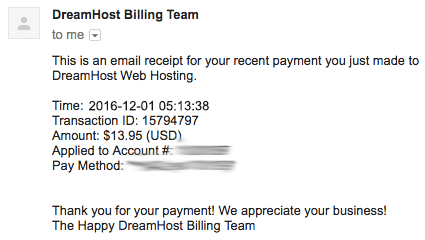
That now leaves me with $486.05 left of the $500 that I’ve allocated to validating this business idea.
However, since I’ve had so much experience over the years with quickly whipping up (read: very simple) WordPress websites to test out ideas, I already know that I can take a stock self-hosted WordPress template and get a functional website ready to go in no more than 1-2 hours.
I view this ability as a strength of mine—I’m working with the tools and skill sets I already have. Call it what you will, but you have to play with the cards you have at your disposal today.
Right, so how do you start when you can’t just pull a website out of thin air?
Google Docs (free).
Like the vast majority of people just getting started with their business ideas, if you don’t already possess the ability to quickly build a simple website, my advice is to work with what you’ve got and leverage the immense number of free online business tools already out there, like Google Docs.
What skills and strengths do you already possess?
Can you make do with creating a simple Google Doc outline of the solution you want to build?
Don’t sign up for paid email list-building tools to collect leads either. Save your money.
Go with either a free Mailchimp account or even better (less time and effort), use a Google Form to collect email addresses for your first potential customers (we cover how to do that in my free course about Finding the Right Business Idea). They’ll be stored in an excel-like Google Sheet (for free) where you can reference them and easily send email updates anytime in the future.
Now, I’m going to take a step back.
Since I already started to deviate from the advice I usually give, I’m taking a step back.
I’m not going to launch the website yet.
It’s not worth investing the time building a website before I know exactly what I’m going to be selling.
So, I’m going to turn to more manual, organic methods of connecting with people I know will be interested in hiking in California. I want to hear from them, exactly what they need before I go out and build a solution to a problem that doesn’t really exist (like I’ve done before).
…
…
UPDATE #1: Elevator Pitch, 47 Email Subscribers, Generating Product Ideas and a Giveaway.
Dec 8th: As I ended last week’s update, this week’s work began with taking a step back and going to more manual, organic methods of connecting with my audience and learning about exactly what they want from me within the topic area of adventuring & hiking in California.
Manual. Organic. Natural.
But before I began my manual reach out, I had to craft an elevator pitch so I could concisely describe what my website is going to be so my friends will quickly understand what’s in it for them if they decide to join my early feedback list. This is particularly difficult when I’m still not 100% sure what this business will actually be once it launches, but that’s not important. Pushing forward.
What IS important is that I communicate the value my early readers will get from checking out my website. The product, service and monetization will come later once I’ve learned how to give these early readers exactly what they want and need—for now, I’m gathering my circle of people to test with.
Crafting an elevator pitch.
With focus on value, I sat down and wrote out a list of what I thought was missing from current sites that tried to be hiking guides, adventure manuals and general resources for doing cool stuff outdoors in California.
Surprisingly, I found that most of the websites talking about hiking and outdoor adventures in CA had pretty mediocre content—images were often stock photos, the written content tended to be overly generalized and not very helpful for hikers seeking to capture great photos while they’re on a hike (a narrow niche I think I can address very well). I think there’s a serious opportunity for having hiking guides and outdoor adventure resources that have a significantly higher quality of images and other content.
So, my hypothesis is that by going into content mediums like drone footage and 360 cam images (that others aren’t trying in this space yet), I’ll be able to win some readers that appreciate the new innovations and higher quality.
After 20 minutes of research, I came up with this short elevator pitch that I could customize for each person I reach out to:
Hey [First Name]! I’m building a new site I thought might be up your alley as a fellow adventure junkie.. it chronicles all of the best places to find adventures in California, go on awesome hikes and capture unique photos from each spot while you’re there. I’ll be grabbing photos, videos, drone footage and 360 cam images to make this really awesome. Would you be interested in getting updates on this?
Is it perfect? No. But that doesn’t matter, I’ll refine as I go and tweak it over time as I learn more about what my audience wants.
Manual outreach begins.
The first thing I did was started texting my closest friends and old co-workers I still keep in touch with. Only the ones who I thought would be interested in a website about hiking and adventuring in California. Here’s what those text conversations looked like:

Before I started my reach out, I did my best to quickly make sure these friends would be within my target so I wouldn’t waste time presenting an idea they wouldn’t be interested in.
To me, being within my target market meant that each friend I reached out to needed to (1) live or frequently spend time in California and (2) have a somewhat active lifestyle, which would indicate to me that they’ll probably be interested in adventuring and hiking.
After going through the 20 people in my recent iMessages conversations who I thought would be a good genuine fit for this, I had 17 email subscribers who’d be interested in getting updates on my project.
Some people said yes, some said no and others I could tell were just saying yes to be nice. I only added the 17 people who I thought were genuinely excited—the last thing I want to do is to guilt trip friends into pretending like they’re into an idea.
17 email subscribers. This was hardly enough to feel confident in when it comes to actually taking the time to build a proof of concept for my site yet, so I took my reach out to the next level.
I pulled up my list of Facebook Friends (2,119 as of today’s date) and started scrolling through to see who I may have missed. Each time I came across someone who I thought could be right for checking out my site, I added them to a GoogleDoc Excel sheet so that I could easily keep track of all my leads.
Here’s a snapshot of my tracking sheet (and here’s a template you can grab for free):

I stopped after getting to 100 potential people I could ask to join my early feedback group.
Then I again began sending emails, texts and Facebook messages to the people on this list and updated their status back in my Excel tracking sheet as I heard back.
Here’s what those emails looked like with a couple of friends. Matt is a hobbyist adventure photographer and we used to work together at CreativeLive. Charbel is an entrepreneur that shares a lot of the same interests as me, so I knew they’d both be a good fit.
I’m friends with both of these guys, but didn’t feel like texting was as appropriate for something like this, so I went with email based on gut feeling—I didn’t want them to feel too pressured to respond if they didn’t want to.
Notice again how my outreach emails are custom tailored to each person and mention a mutual interest we have or reference our last conversation. I’m not copying and pasting my elevator pitch template and you shouldn’t either.
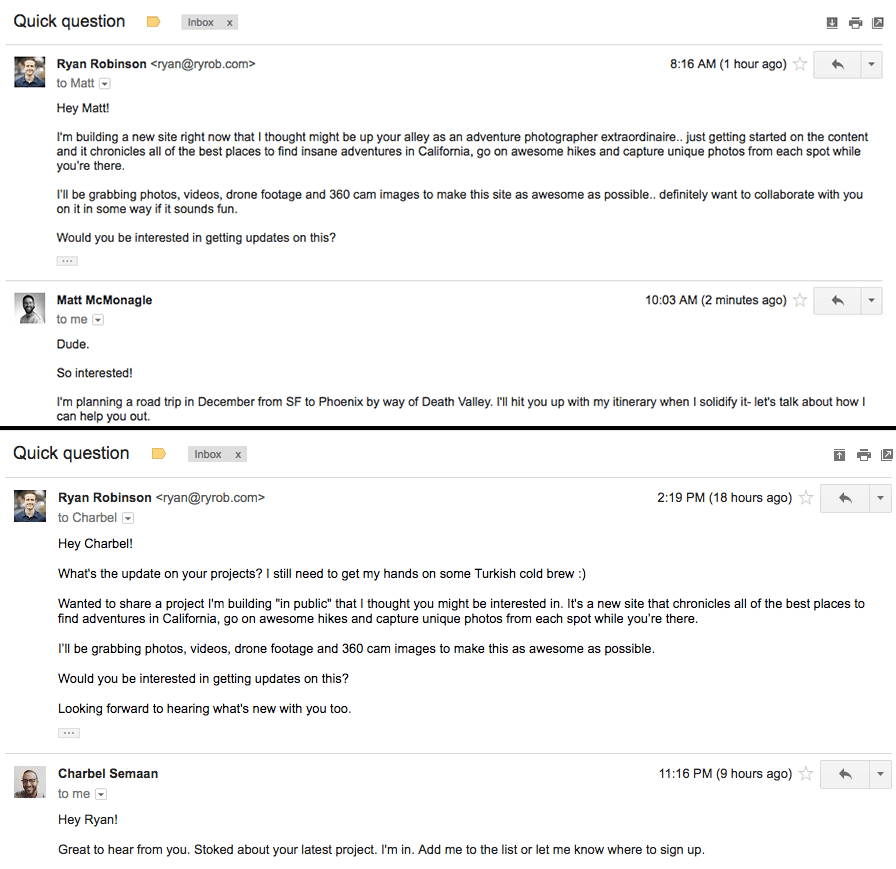
Here’s a pitch I made over Facebook messages to an old friend of mine, Randi who’s now a photographer in Southern California.
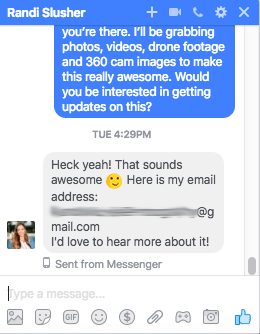
My response rate was by far the highest when I texted people. 19 of the 20 people I texted got back to me with a yes or no. Email has been the second most effective (feels more like a work-related task) and Facebook messages have been by far the least effective (people often forget about their Facebook messages or don’t frequently log in).
I recommend going with texting people as your primary outreach medium to build your early feedback group.
47 email subscribers.
I’m now up to 47 people who are interested in getting updates on my hiking & adventure California website. I’m going to keep going until I’ve reached out to all 100 people I flagged on my prospect list.
Since several of the friends I’ve reached out to are photographers, a few of them proactively offered up letting me borrow some of their equipment to help document the hikes I’m planning to go on because they liked this idea so much. They want to be part of what I’m planning on building in some way.
This is one of the biggest benefits of involving your target audience in the creation process as you go—some of the people that are interested in what you’re doing will want to participate with you. I’m all in for that.
I now have access to a drone and a 360 cam—SCORE.
This could’ve been perceived as a barrier to entry for this business, but I side-stepped that by involving my target audience in the process of building. These items are pricy to buy and still a little expensive to rent, so it’s great knowing that I’ll be able to borrow this gear when it’s time to shoot my content.
MailChimp and Gmail (whoops).
Over the past week, I also took 10min to sign up for a free MailChimp account on my lunch break so that I’d be able to send email broadcasts to my early subscribers in the near future. In hindsight, did I absolutely need to do this already? No. It was a waste of that 10min.
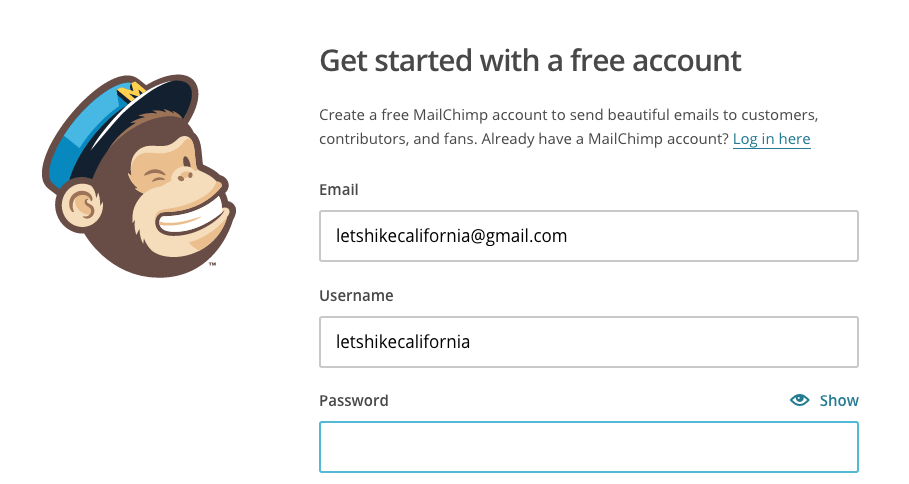
I won’t be using this service immediately since I’ll be primarily sending individual emails to my early subscribers to keep it very personal, but got excited and wanted to lock down the MailChimp account now while I was thinking about it.
No particular reason why I did this already—and to be honest I really didn’t need to. In retrospect, this was not the best utilization of my time and isn’t how I advise managing opportunities.
Same goes for the Gmail account I created this week—did I absolutely need to get a new email account just for this website (that doesn’t even exist yet)? No, not yet at least. But I got excited and did it.
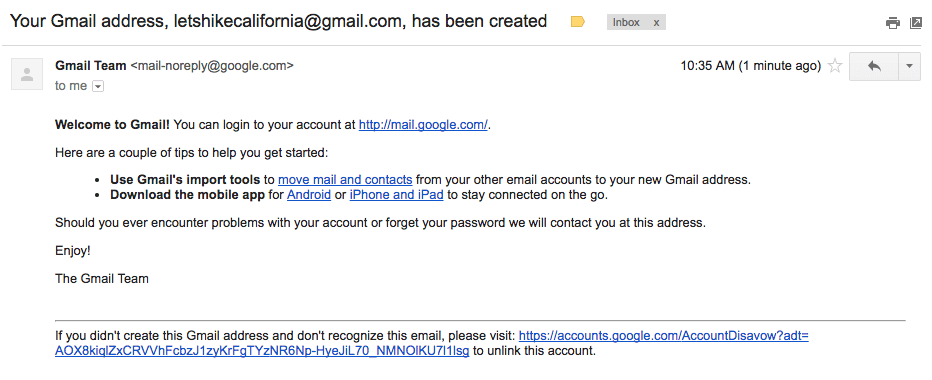
I don’t have plans to use this email address immediately either—I’ll get to that point once my site is up and I need to list a more relevant contact email.
Generating product ideas.
I’m going to keep these 1-on-1 conversations going with my early feedback group. My goal is to learn how I can best help them—and to come up with product or service ideas that deliver value.
I already had a few ideas for products and services in mind that I think my audience will find value in, but during a few of my conversations with my early feedback group already—something incredible happened.
My audience started telling me what they wanted.
Check out this text from my friend Michael that lives in Los Angeles, a traditionally very tourist-heavy city.

He identified one of his major pain points when it comes to finding good local hikes and adventures to do that aren’t touristy like hiking up to the Hollywood sign. He lives in LA, so he’s already done all that—now he wants “off the grid, local and culturally interesting experiences.”
I like that. There’s definitely something there with this angle of providing a more in-depth point of view and guide to the “locals only” experiences in California. The hikes, adventures and destinations that are just off the beaten path.
Perhaps there’s a way to monetize an in-depth guide to 10 or 25 of these destinations—with high quality photos, video, drone footage and 360 cam images to make it particularly unique.
Two other friends of mine, Bryan who worked with me at CreativeLive and loves photography, and Alan who’s an active outdoor enthusiast in his own rite, now work together and talked about my website idea at lunch.
They came to me (in a Slack group we have together) with a great idea for a service that they wish existed in the hiking and outdoor market.

Interesting. I like this one too.
I honestly hadn’t thought of that—providing a monthly subscription service where I line up a curated, local adventure and discounted deal for my subscribers to go on once a month. Keep it simple by not handling transactions myself, but instead connecting them directly with vendors.
This concept could also be combined with the same approach that my friend Michael alluded to earlier as well—off the grid, secret, less touristy adventures that I could line up for my subscribers.
This is getting exciting.
I’m going to take this weekend to build upon these two ideas and see what else I can come up with as far as product & service offerings to pitch my early feedback group members over the next couple of weeks.
Building my audience beyond just my close circle of friends.
A huge component of what I teach in The Launch Formula is that you need to get objective feedback on your ideas from both people you know and people you don’t know. So, it’s time to strategize on how I’m going to do that—quickly.
I’m starting to build some confidence now that I have 47 email subscribers in my early feedback group, but I still want to spread this out to friends-of-friends and that layer of second or third degree connections that may not know me personally. Those are the people who are likely to be most honest with me.
On top of that, before I invest time into building anything, I want to get more people engaged in my idea as it takes shape.
Enter: A giveaway idea.
One of my favorite potentially viral marketing tactics that I used during my time at CreativeLive was giveaways.
The idea is simple: Run a sweepstakes and give away an awesome, relevant product or service for free in exchange for asking entrants to sign up for your email list first. Incentivize them to share the giveaway on the backend after they sign up by offering a few “extra” entries into the giveaway for every friend they refer to my giveaway.
If I get 50 of my early feedback group members to enter my giveaway and share the giveaway with just 3 of their friends each… that would lead to me generating 150 new subscribers to join my feedback group.
There are tons of tools for doing getting a giveaway up and running very quickly and effectively.
I chose KingSumo Giveaways by AppSumo, a WordPress plugin, mostly because I have a lot of friends whom it’s worked well for and Noah Kagan who runs AppSumo has been a great source of advice to me—I figured I owed him one by now.
Here’s a snapshot of the giveaway landing page in action on Buffer’s website:
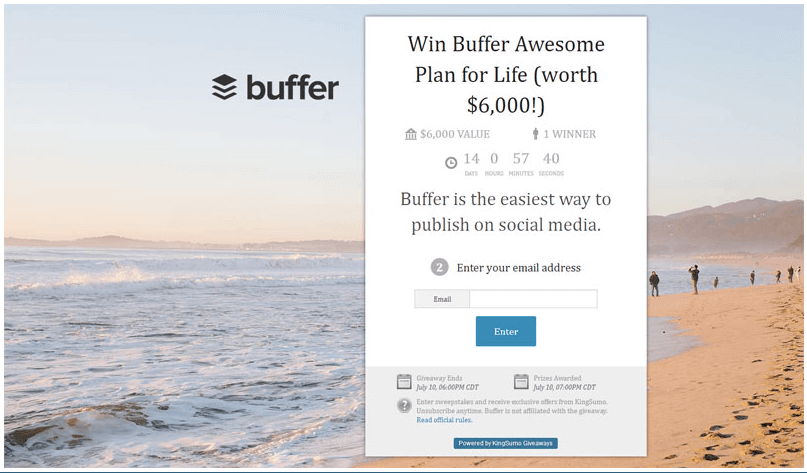
I found a flash deal for KingSumo Giveaways online from an affiliate partner of AppSumo (which of course is no longer available) and picked it up for $49.50. Seriously, it was just lucky timing that I got this discount. These discounts come and go all the time, so keep an eye out and be patient.
You can still grab the plugin from another affiliate of theirs for $99 right here and if you sign up for their email list (and AppSumo’s), they often discount down to the $49.50 price point when running specials.
Now, I’m left with $436.55 of the $500 I’ve limited myself to. I’ll have to get creative with my budget for this giveaway.
Since I only want people entering my giveaway who are likely to be interested in hiking & adventuring (preferably in California), I’m probably going to make my giveaway item(s) very closely related to hiking gear. Things like: A backpack or tent, sleeping bag, jacket and so on.
But first, I’m going to take the weekend to ask a few people in my audience what type of gear they want (and will use)—I’ll run a few giveaway suggestions by them and see what they think.
What’s next?
Once I land on the giveaway item I’ll be offering to my early feedback group, it’s time to promote the hell out of the giveaway. I’ll start with opening it to my small email list, then spread out.
Next, I’ll build a targeted list of online communities, forums, Instagram & Twitter influencers (think: outdoor photographers in California) who might be interested in sharing my giveaway with their audience in exchange for a future feature on my site once the site is live. It’s a long shot since the site doesn’t exist yet, but all I need is a couple of yeses that could make all the difference. To help boost your legitimacy a little bit before your outreach, you can consider buying Twitter followers as a means to stand out a bit.
After my email list has grown in size from my giveaway, I’ll individually pitch my refined product or service ideas to a handful of people in my feedback group. I’ll take their consensus on what sounds most appealing, whip up a quick landing page and launch it on pre-order to my full email list.
Will all of this going according to plan? No way.
But I’m going to grow and adapt when I need to… for now, it’s back to work.
…
…
UPDATE #2: 305 Email Subscribers, Strategic Connections, Reddit, Launching the Giveaway and Influencer Outreach.
Dec 15th: Buckle your seat belts because this is a HUGE update. As Keri Vandongen put it (near the bottom of the comments section below), this feels to her “like she’s reading my diary of validating a business idea,” which is a huge complement and also exactly what I’m going for. So, brace yourself for this latest entry. ?
Here are giveaway email subscriber numbers, as of this afternoon:
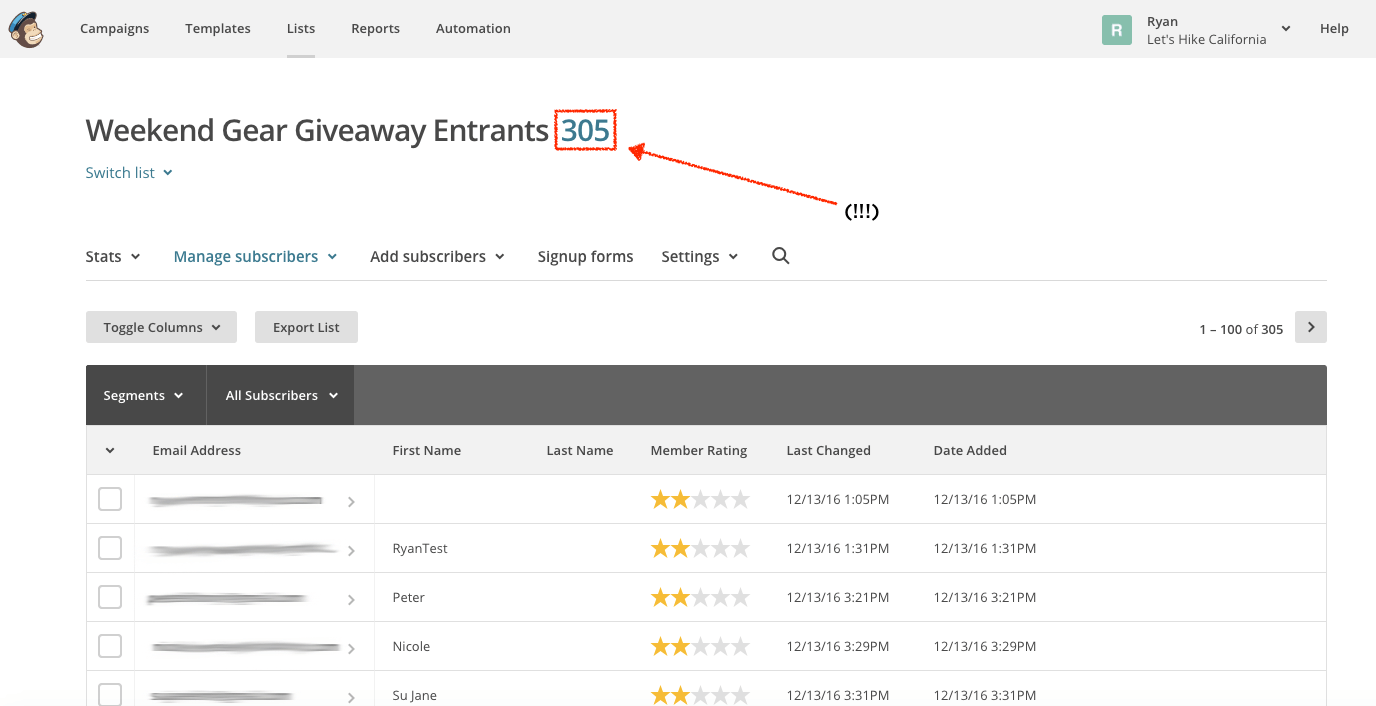
I’ve yet to count my total number of subscribers (assuming some people from my early feedback email list may not have joined this giveaway list), which I’ll be reporting on in the next update.
Now, before we dive into the specific strategies and tactics I employed to achieve massive results this week (305 subscribers and still growing quickly), I want to highlight a recurring theme that’s incredibly important to any entrepreneur looking to validate a business idea and build something meaningful.
Sharing your work is hard.
I get it, trust me. It’s STILL hard for me, even today. It’s hard because you’re exposing who you really are deep down. You’re making yourself vulnerable. You’re actively creating opportunities for people to judge you and the quality of your work.
However, the more people I reached out to and shared my idea with, the more great things started to happen for me.
It was genuinely difficult for me to share this website idea and ask for feedback… even from 47 of my closest friends and acquaintances whom I know won’t judge me.
As I was contemplating hitting send on my first big update email (and the giveaway announcement) to the 47 or so subscribers in my early feedback group on Tuesday of this week, I had a rush of anxiety.
- What if my friends think what I’m trying to build is dumb?
- What if asking them for feedback on a business idea damages my relationship with them?
- What if I end up failing with this idea? How will I explain that failure?
These were the types of questions running at light speed through my mind.
I literally tried to think of excuses for why I shouldn’t send the email on Tuesday… Oh Tuesday’s are the busiest days of the week, they probably won’t have time to read my email. I bet if I wait until Wednesday or Thursday, I’ll get a higher open and click rate (the curse of thinking like a marketer).
In the end, I decided to hit send despite all of my reservations.
Here’s how—I reframed the situation by asking myself, “Which decision (to send or not send) will you regret making the most in 1 week? How about 1 month?”
In this context, the answer was a no brainer. I’d clearly regret it more if I didn’t take the opportunity to confront my fears and anxieties—if I didn’t give myself the chance to see if this idea really has the potential to succeed.
In 1 month from now, who’s going to care that I sent them an email asking for feedback on an idea and to enter a giveaway to win some pretty cool stuff? Nobody.
Here’s me sending out my first update + giveaway announcement email to my early feedback group using the free Chrome extension, Yet Another Mail Merge. I highly recommend it for sending customized bulk emails.
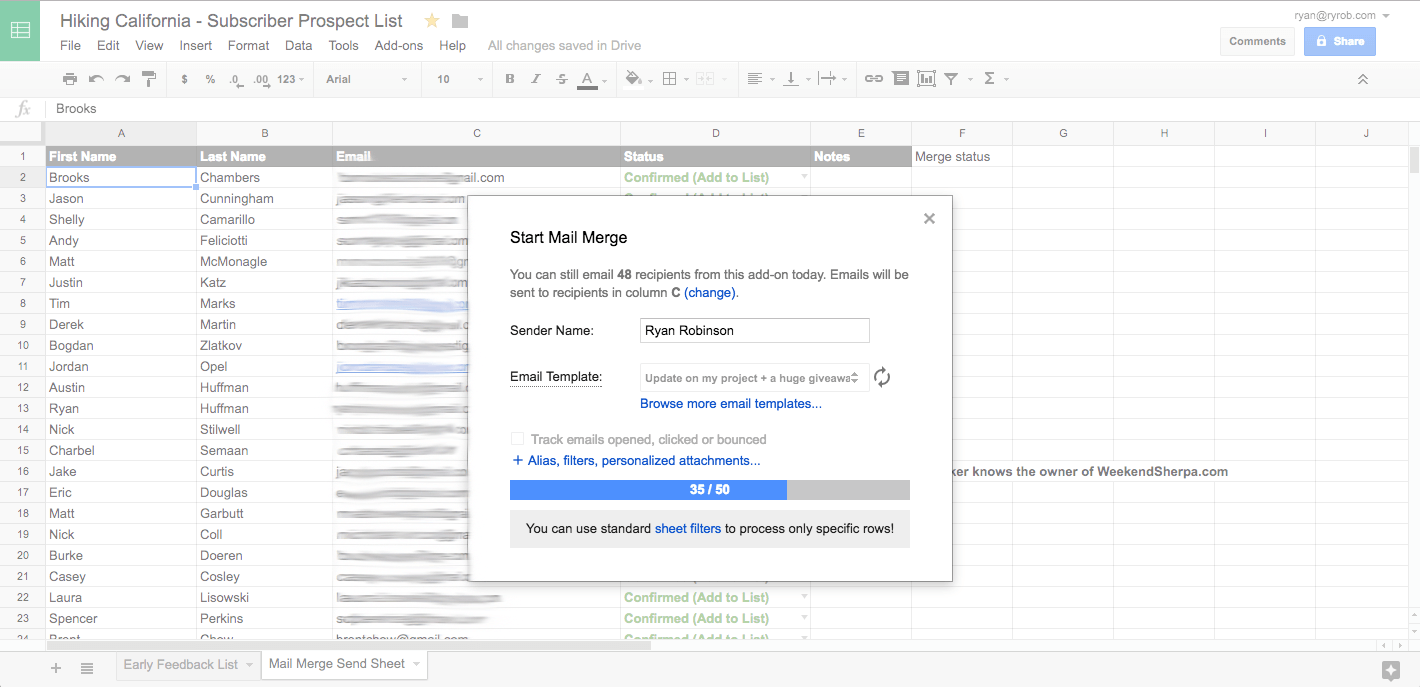
After sending out this update and giveaway launch announcement, a lot started happening.
Let’s dig into it.
Reaping the rewards of sharing my idea.
Almost every time I shared this new website idea with a friend, old co-worker, family member or otherwise, they had something insightful to share with me.
Whether it was a tip for their favorite must-see hike in California for me to document, directional advice on how I can position my content to be unique in this crowded space, a referral to someone they know who either operates a site in this space already (or has worked with this topic area in the past), or even potential revenue-generating business models for the site based on their biggest pain points—the constant theme has been that by sharing and growing the size of me early feedback group, they’re helping me build my business.
Seriously, this is something I want you to PLEASE read twice.
By involving people who are interested in the solution I want to build, they’re naturally helping me to create a version of it that they’ll find value in.
This means I’ll have an engaged, involved group of people who are already (practically) guaranteed to at least consider paying me for what I’m about to launch. They’ll already feel like a part of my site when it launches.
Let’s start with this email from my friend, Jake just a couple hours after I texted him about this idea.
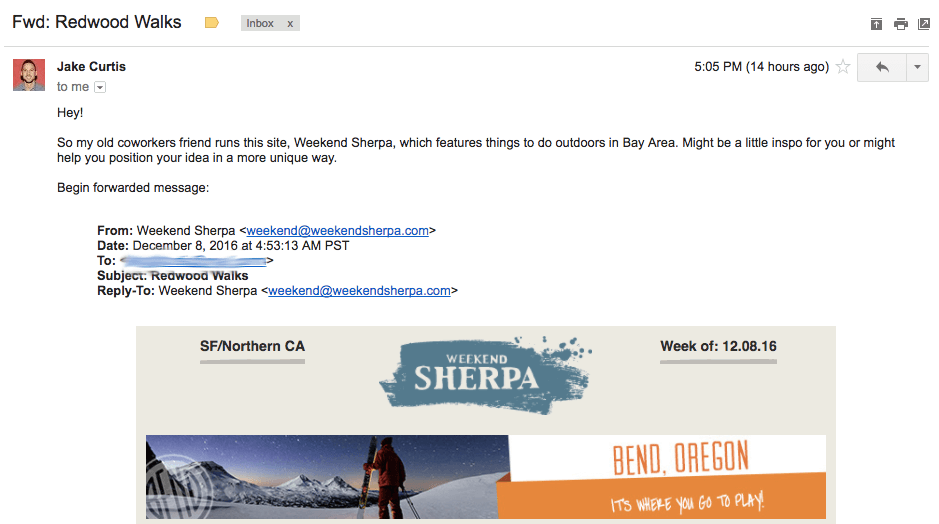
(!!!) How amazing is that?
Jake took an active role in helping me shape my idea by sending me an existing site that could serve as inspiration for me as I build—and give me a sense of how to make my content more unique or different than what’s already out there.
What’s even more impactful is that he’s somehow connected to the person who owns Weekend Sherpa, a site that’s been in the California outdoor niche for over ten years.
Think that’s a person I should connect and collaborate with in the future? (Hell yes)
If I hadn’t shared my website idea with my friend Jake, I would never have known this connection existed.
Share what you’re working on—you’ll be surprised by how many people will want to support and help you.
This happened again with another one of my friends, Matthew.
Knowing that he and I share a common interest in trail running around the Bay Area, after texting him about my idea, he mentioned that a former business partner of his worked with one of the HUGE original websites in outdoor activity recommendations—Every Trail.
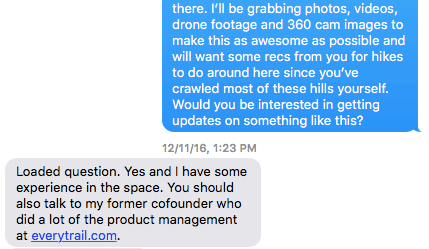
Talk about another person I’m going to want to connect with soon.
By sharing my idea with less than 50 people so far, I had already uncovered hidden mutual connections to 2 of the largest, most established, reputable hiking and outdoor adventure websites in California.
No joke, I had no idea those connections existed. And in business, an introduction from a friend goes a long way beyond just a cold outreach email sitting in the inbox of someone you don’t know.
These connections can be very powerful potential partnerships for me in the near future.
Deciding on what I should give away (with the goal of building an email list).
Before deciding to allocate some of my budget to buying gear for my giveaway, I wanted to make sure it’d be stuff that my target audience would actually want—something they’d be comfortable signing up with their email address for a chance at winning.
I had a few ideas in mind already, but because I know the importance of asking my audience what they want (instead of trying to guess and decide for them), I decided to ask them which item they liked best.
It was between an Osprey hiking backpack, GoPro HERO 5.0 and a FitBit Surge—all gear that someone who’s active in the outdoors will appreciate.
So, I reached out to a few of the people in my early feedback group and did a quick poll to see what type of gear they’d want most.
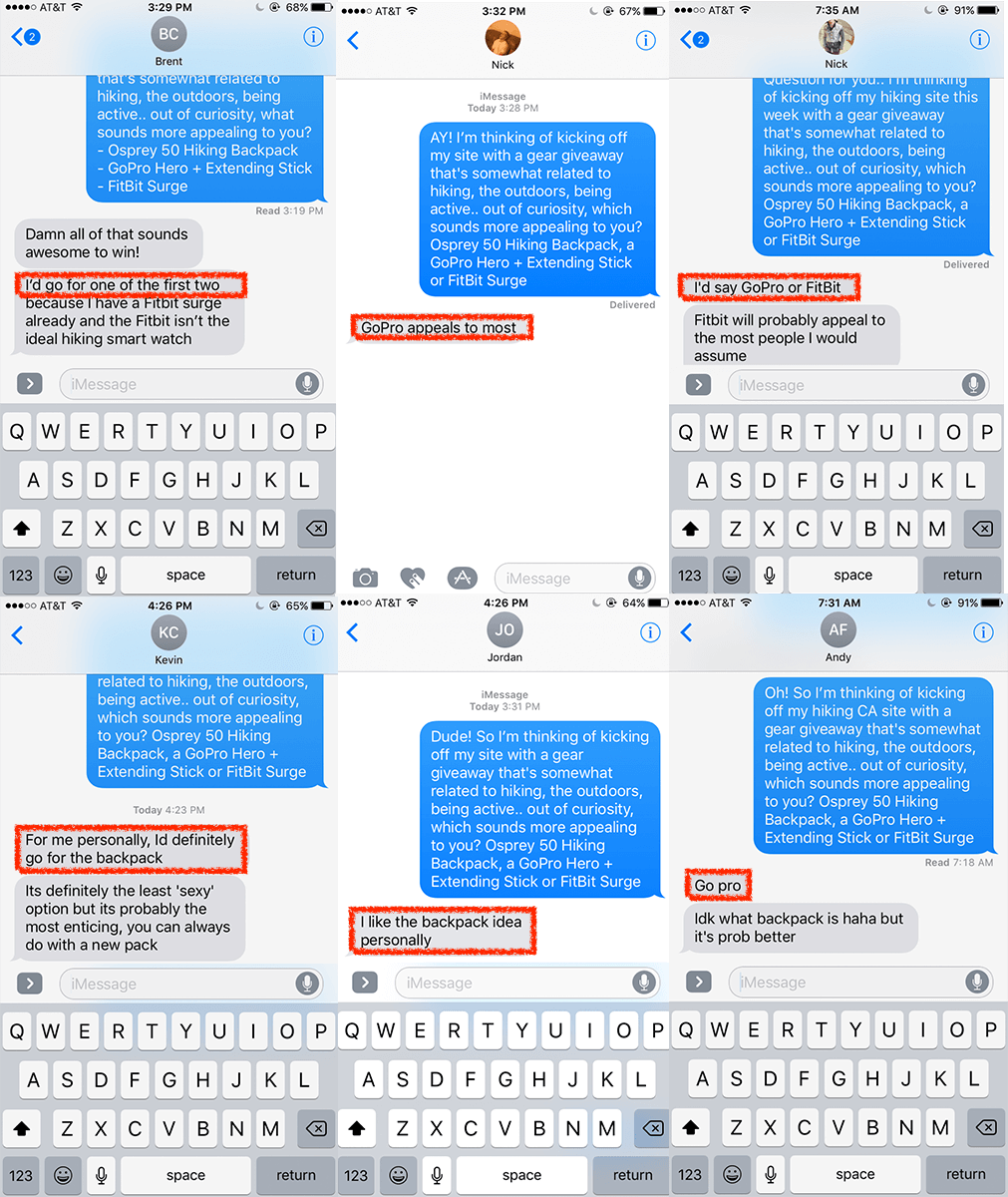
The answer: GoPro’s and hiking backpacks.
Next, I did a quick check on Google Shopping & Amazon to see how much the GoPro and Osprey bag would run me.
Surprisingly, I found that I could get both of these two items for relatively cheap compared to how much I thought they’d cost.
The GoPro HERO 5.0 MP would be somewhere around $175.
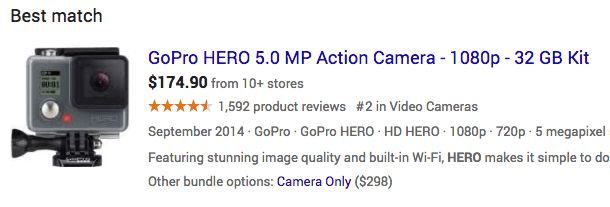
The GoPole extending stick goes as low as $28.

And the Osprey Atmos 50, my favorite pack of theirs is as low as $170 + $15 shipping.
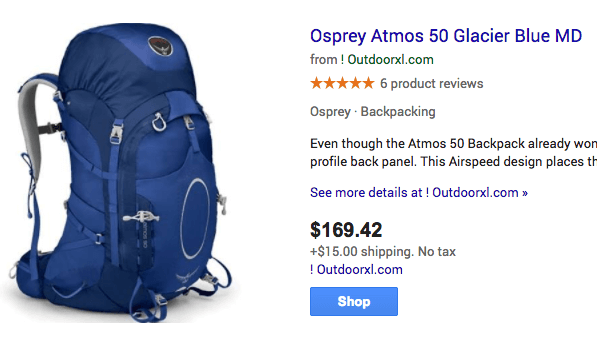
Since the feedback from the 6 people I asked about which giveaway item they’d want most was pretty split evenly between the GoPro and the Osprey pack (and the cost for both would still be within my budget), I decided to just include both of them in the giveaway to make it more exciting and appeal to more people.
Plus, I knew that at least these 6 people would be pumped to see both in the giveaway.
Buying both of these items would take up a whopping $388 (of the remaining $436.55 I have left for validating this business idea).
Important Note: I still have not bought these items… for a very good reason.
I don’t love spending money. I also don’t like taking big risks without a clear potential return.
Over the next couple of weeks (before I have to fulfill this giveaway to the winner), I’m going to work my ass off to try and find a sponsor who’d be willing to either gift me these items or discount them heavily.
There are literally more than 260+ sporting goods stores in the greater SF Bay Area. I’m going to call or visit a few dozen of them and try to work out a deal in exchange for promoting some of their products and sales to my email list of outdoor adventure junkies.
Most companies build in margins that allow for discounts, promotions and deals—I’m willing to bet they’d be up for giving me even a 25% discount on buying this gear in exchange for exposure to my highly targeted audience.
That’s worth something. It’s a numbers game, but it’s only a matter of perfecting my pitch and talking to the right decision-maker.
But in the meantime, I still don’t like spending money.
So, to compensate for the money I’ll eventually be spending on buying these items, I decided to make an extra $400 this month just in case I won’t be able to get any sponsors. Here’s exactly what I’m doing to get that extra income:
I knew that $400 in extra income probably won’t be coming from this website idea yet, so I got creative…
1. I’m selling some stuff.
I don’t know about you, but over time I tend to collect stuff. Clothes, shoes, gadgets, the list goes on.
I actually think of myself as being fairly minimalistic compared to a lot of my friends, but to be completely honest, I don’t really need (or use) a large proportion of the stuff I own.
So, yesterday afternoon I went through my closet to look for some stuff I could sell to offset what I’d potentially be spending to buy these giveaway items at full retail.
In 10 seconds, I found a pair of Nike running shoes I had worn once. They didn’t fit quite right, but I had already thrown out the box and receipt (dumb), so they sat at the back of my closet for 6 months. Those went up on eBay about 3 minutes later…
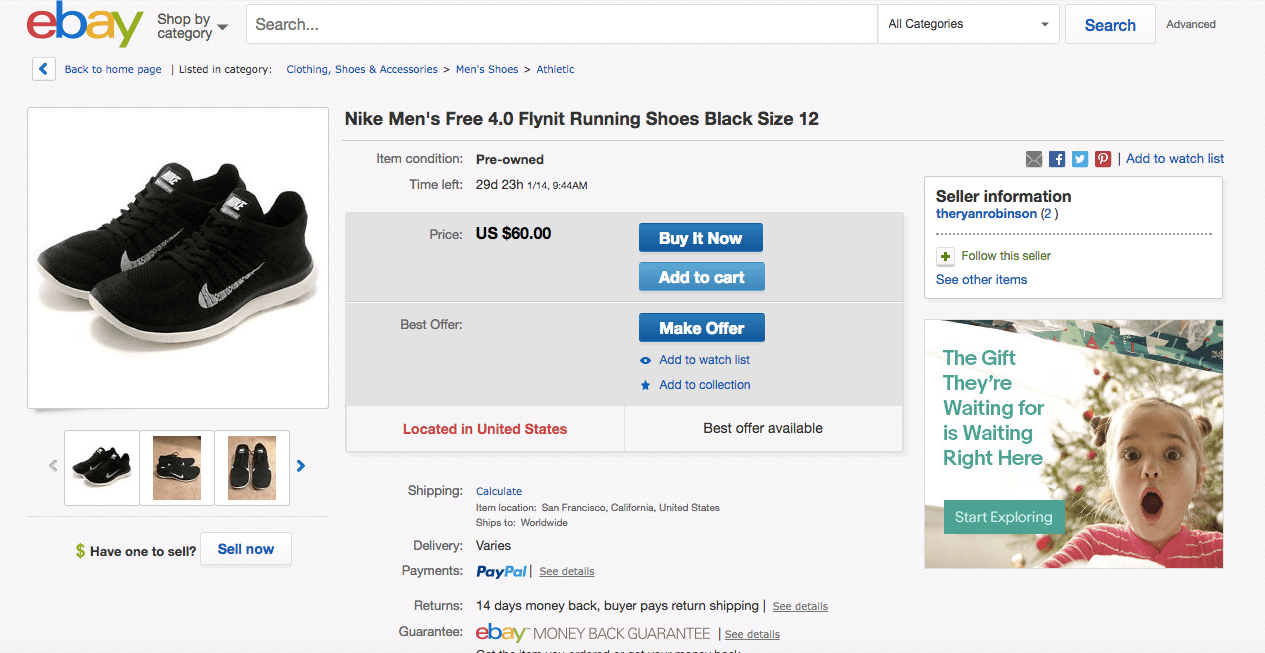
The next thing I found was a pair of jeans I hadn’t worn once, despite owning them for almost a year. Same story. They didn’t fit well, but I had already cut the tag off. Why did I even have these still? Anyway, up on eBay another 3 minutes later…
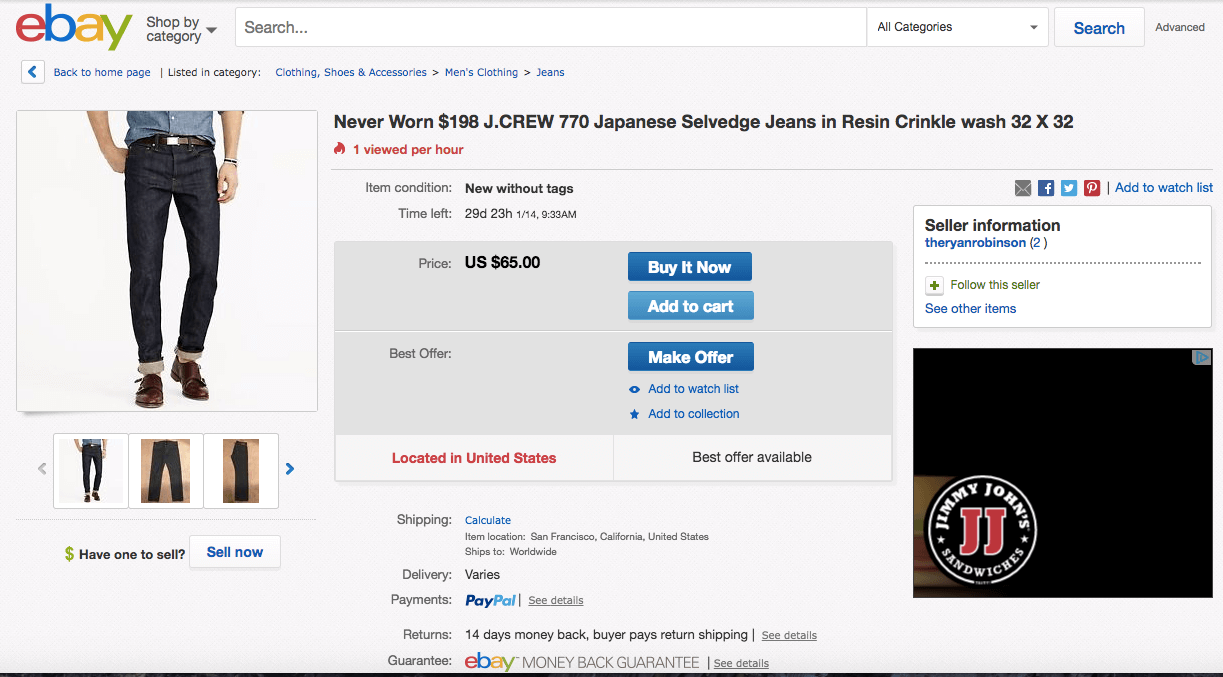
Neither of these are guaranteed to sell of course, but if they do, that’ll be an extra $125 to go towards my $388.
Not bad for 10 minutes of work, plus I thinned out my closet which my girlfriend greatly appreciates. Win-win.
That still left me with a pretty sizable gap, and I didn’t want to take a ton of time looking for more stuff to sell. So, I turned to making some extra money with my craft: writing.
2. I’m using my skills.
This morning, I searched through my Gmail folder I keep to tag all conversations I’ve had with freelance clients (and potential freelance clients) over the years. I frequently turn to this first when I’m looking to restart client relationships and pick back up where I left off with someone when I need more work.
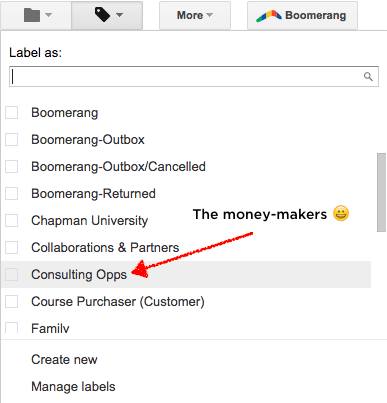
In a few minutes, I found the right opportunity.
I reached out to the editor for a business-related blog I used to write for earlier this year, but for some reason things just fizzled out and I hadn’t pitched a new piece since April.
This particular blog pays $250/article, which is now a little ways below what I typically take for writing a post (a lot has changed this year), but I’m doing this to prove a point ?
Check it out. Blurred because they don’t like publicly sharing writer rates:

In another 10 minutes, I had secured an extra $250 in future income for this month.
Just like that, I had created enough potential upcoming cash flow to cover $375 of the anticipated $388 I’d be paying for the giveaway items if I need to buy them at full retail.
Again, I’m still very confident that I’ll be able to at least get these prices knocked down considerably by knocking on enough doors at sporting goods stores. But, just in case… I wanted to cover all of my bases. Another alternative could be seeking the right small business grant to help fund the start of my business, but I don’t want the strings that come attached to that.
But Ryan, that’s not fair. I don’t have $400 lying around to spend on a giveaway right now and I can’t just send an email to someone & get paid for writing an article today.
Stop wasting time complaining. Seriously.
I just problem-solved the shit out of this situation in 20 minutes.
You can do the same thing in your own way.
Will it take you more than 20 minutes to figure out? Probably, but that’s not the point. The point is that when you want something bad enough, you’re going to do whatever it takes to make it happen.
Here’s a little tough love: In business, you’re going to run into a lot of problems, challenges, tricky situations. It doesn’t slow down—in fact, the challenges usually get more complicated as time goes on and you experience some success.
If you allow yourself to get hung up and stop right here on the very small (but meaningful) goal of validating your business idea, you’re never going to accomplish your biggest goals.
I’m doing everything I have to do right now, today… to achieve my short-term goal of getting enough email subscribers to validate this idea. That’s it. Nothing else matters in this moment.
You have to get creative. You have to become the chief problem-solver in your business.
Even more importantly, you have to realize that you don’t need to make it back the way you lost it. (Which Tim Ferriss also talks about in detail during a recent episode of the Tim Ferriss Podcast)
Meaning, I didn’t need to make the $388 directly from my non-existent website in order to balance out the numbers in my bank account at the end of the day. I could turn to other revenue streams (like selling stuff and using my skills) to pick up the gap in my income and completely pay off this giveaway before even buying the gear.
No excuses. Work with the tools you have and the situations you’re in.
Setting up the giveaway.
Now that I knew exactly what I was going to include in my giveaway, it was time to get into my KingSumo Giveaways Wordpress plugin and whip up a quick landing page.
No frills, nothing too crazy. Again, simple is the name of the game.
Here’s the giveaway page. Sorry you can’t enter—against the rules for me to link to it and use my own audience, remember? ?
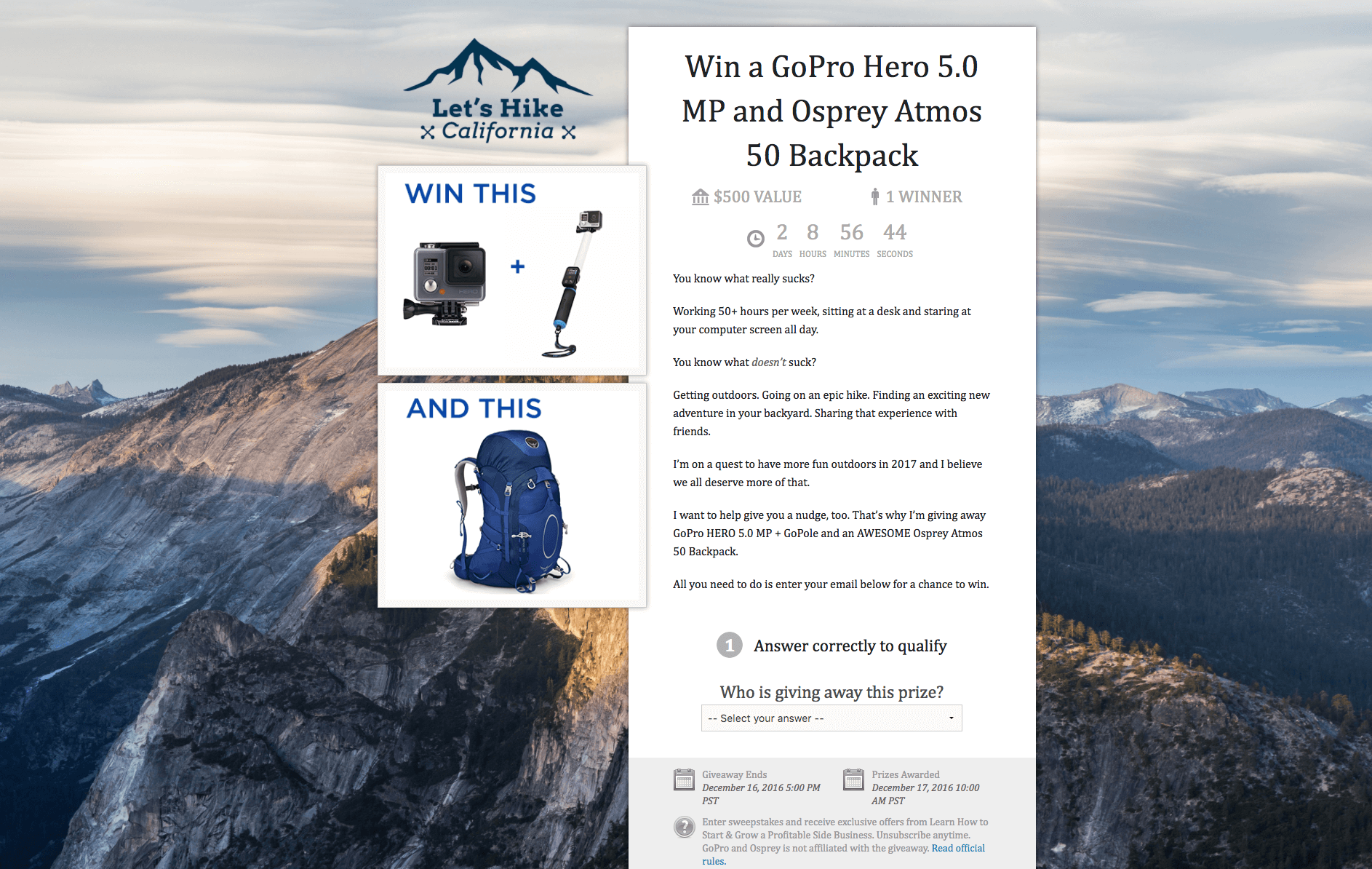
(you can click here to see the full image of the landing page and read the copy easily)
To logo or not to logo? (I made another mistake… sort of)
I wanted this page to look professional to the people who’d be coming here without knowing me, so I decided I should have a logo.
I’m on the fence about this one, but it’s kind of a dumb utilization of time in hindsight, because you don’t really need a logo for a website that doesn’t exist yet. But, I had already gotten the thought into my mind and I couldn’t shake it. So, I limited myself to spending no more than 10 minutes on it.
How do I make a logo that doesn’t look awful in 10 minutes? Ok, problem-solver cap goes back on.
Really quickly, I Google searched for “mountain graphic” and that led me to FreePik.com where I grabbed the first free stock mountain clipart graphic that caught my eye.
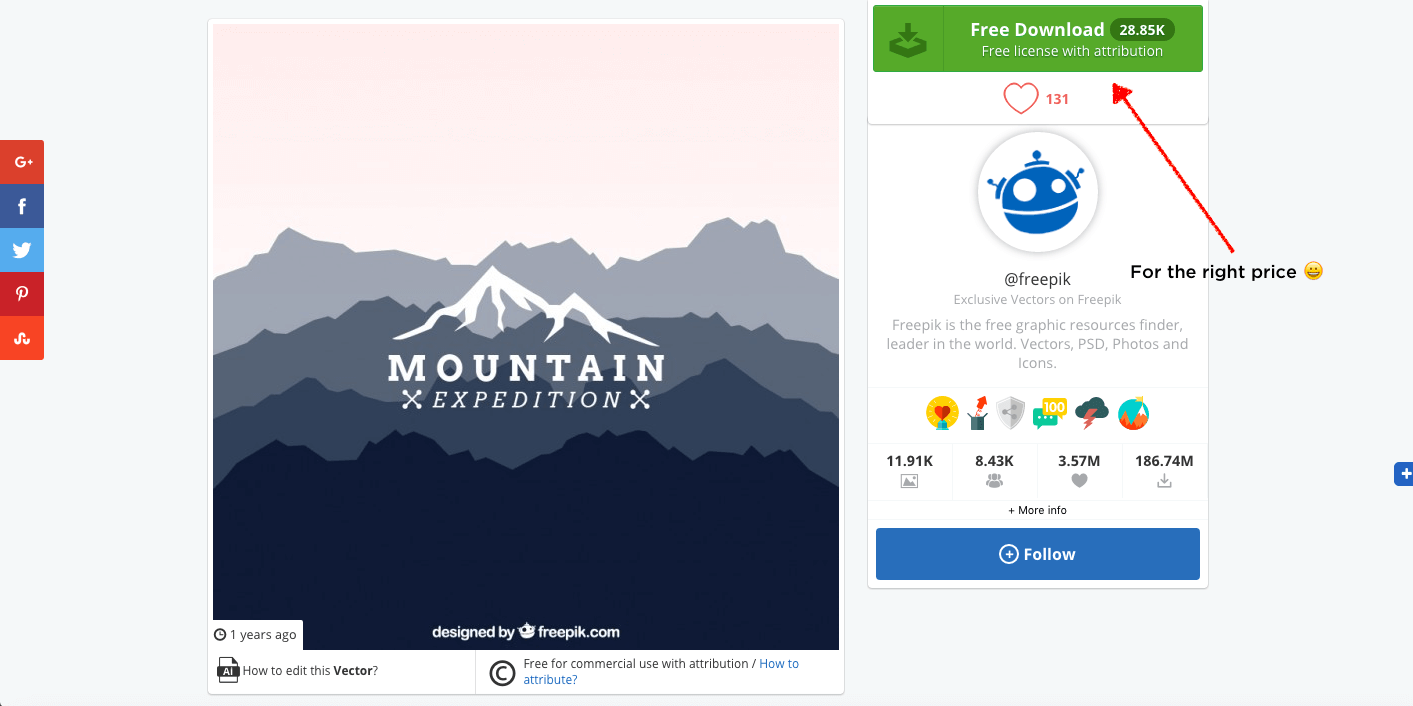
Next, I used my (very limited) Adobe Illustrator skills to quickly change the color of the mountain & update the text to, “Let’s Hike California.”
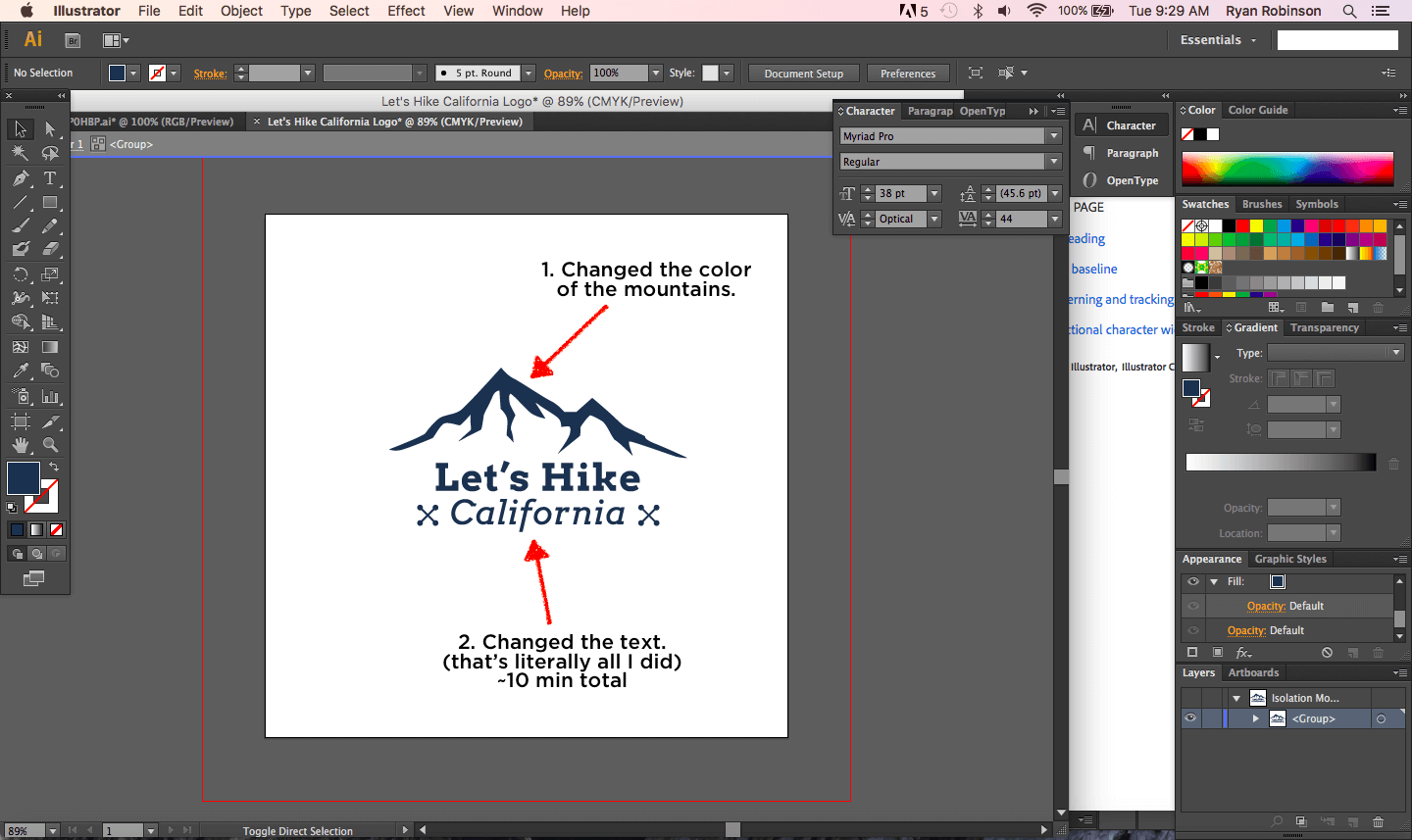
Not terrible for ~10 minutes of work and I now have a logo to plug in on the giveaway page to make it look more legitimate.
After writing some copy that explained the giveaway, why I was hosting it and why people should enter, all I had to do was upload the pictures I had grabbed of the GoPro and Osprey pack & it was ready to go.
The giveaway goes live.
Immediately after getting the giveaway page live, I started writing my first update + giveaway launch email to my early feedback group of 47 subscribers (the one I mentioned earlier in this update).
I wanted to keep it as short as possible, thank these friends for their feedback and help thus far and explain the specifics of the giveaway in an easy-to-follow manner.
Here’s that email:
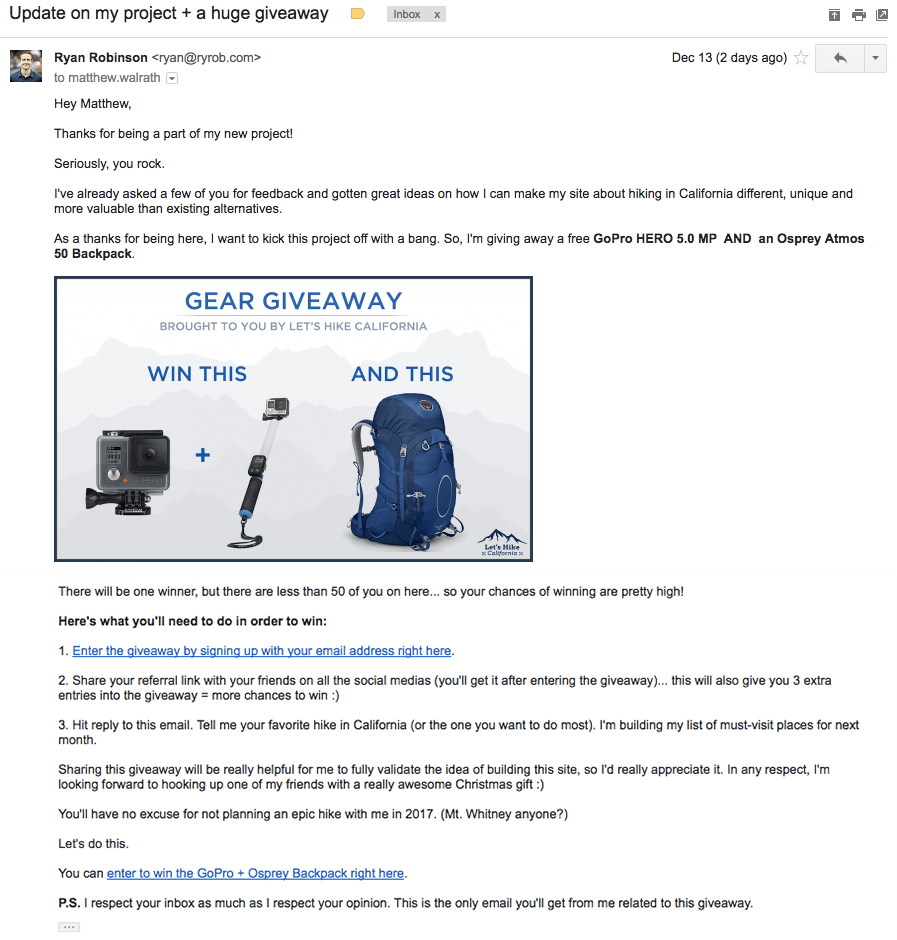
(you can click here to see the full image of the launch email and read the copy easily)
Did I really need to design an image to use in just this email? Nope, that’s another (sort of) mistake.
But like with the logo, it took me ~10 minutes to get it to what you see below, so I figured that was justified in case any of my friends wanted to share the image and promote the giveaway on their social profiles.
Pretty much immediately after sending out the giveaway link to my early feedback group, they started to enter.
And thanks to the clever guys at Appsumo who built the KingSumo Giveaways plugin, immediately after you enter the giveaway, you’re presented with this screen:
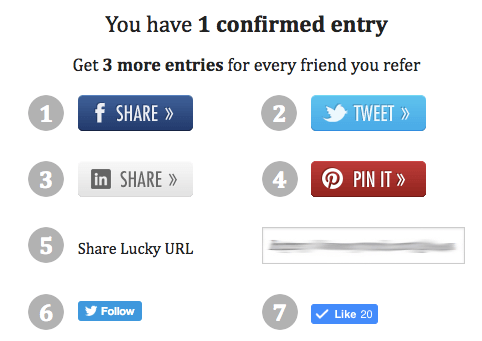
This means that everyone who enters my gear giveaway is incentivized (in a big way) to share the giveaway with their friends—giving this the potential to go viral.
For every friend a contestant refers to my giveaway using their special link, they’ll get 3 extra entries, thus increasing their chances of winning. Genius.
And… the giveaway is starting to go a little viral.
My friend Matt, who’s on my early subscriber list shared his giveaway referral URL with his Facebook friends.
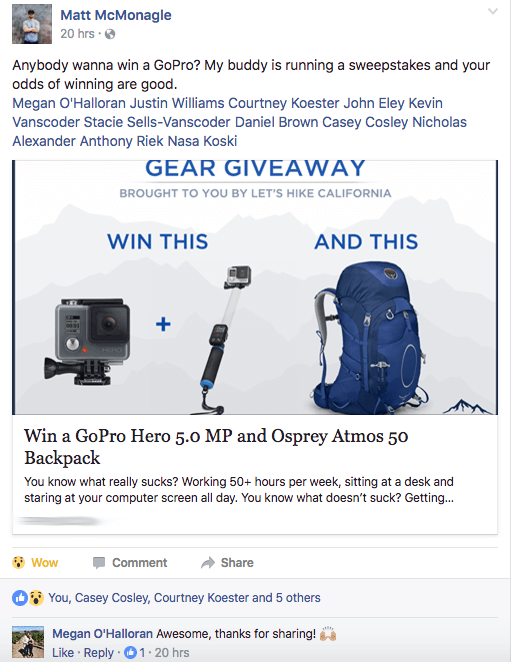
A lot of his Facebook friends (people I don’t know) joined the giveaway afterwards, and he got a ton more entries.
Multiply this effect by the ~20 friends who replied to my email telling me they joined & shared the giveaway, and I now have the recipe for something that could generate a lot of email subscribers.
I started to notice people I didn’t know sharing the giveaway on Twitter…
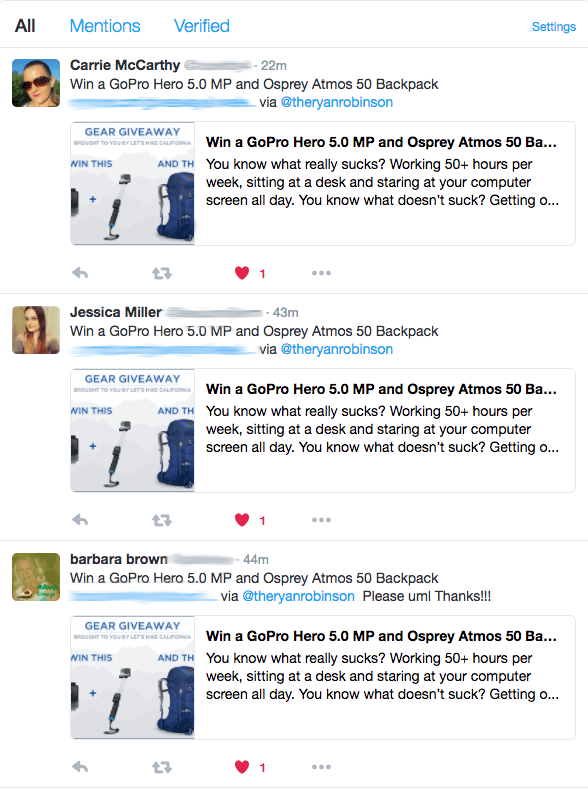
I also started to notice a trickle of traffic coming in from Reddit, which means someone who joined the giveaway shared it in the /r/giveaways sub-reddit.
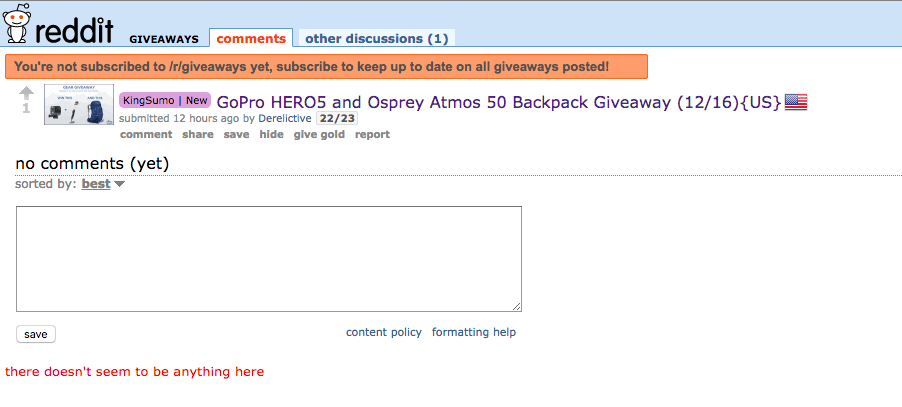
Not ideal that it went up onto Reddit in my opinion, since that’ll probably lead to a lot of people joining who just want want free anything and aren’t really into hiking, the outdoors or even spending time in California.
Oh well, this can at least lead to a higher chance of the giveaway going viral and getting me a high volume of potential new customers which could make up for the lack of targeting on them.
After the first 24hrs or so, I had about 160 new subscribers who’d joined through the giveaway, but momentum was starting to slow down a bit.
So, I wanted to try out another marketing tactic (specifically an Instagram marketing tactic) that has traditionally worked very well for me, especially with my freelance content marketing clients: Influencer marketing.
Influencer outreach on Instagram.
One of the friends I strategically chose to include in my early feedback group, Justin Katz, is a super talented photographer here in California.
He has a really engaged Instagram following and takes a ton of his free time to go out and capture amazing images from different trails and locations around the state—he’s literally my target market for this site. And so are his followers.
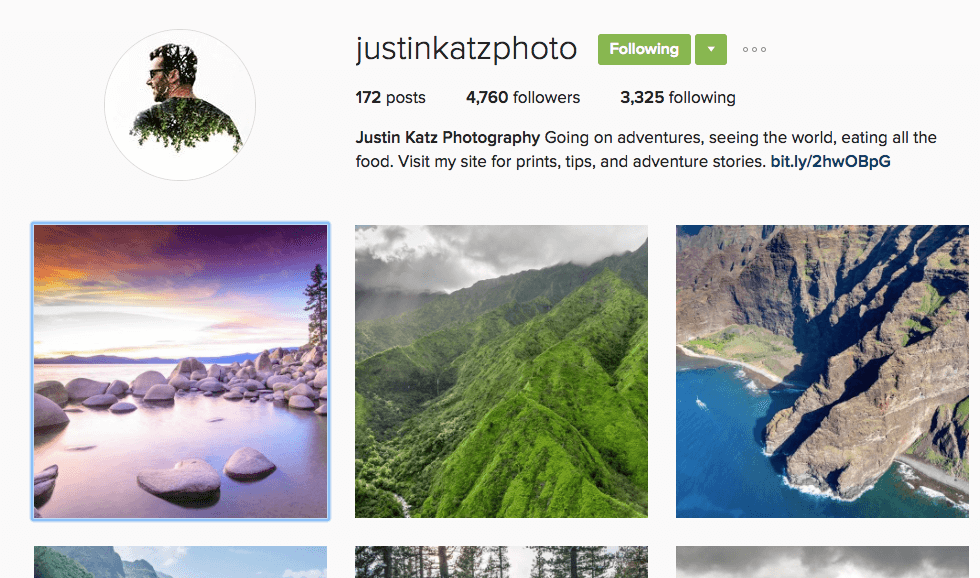
See what I mean? Yeah.
He also has a sizable following where he’s learned how to grow a blog covering topics like the best gear for photographers, online courses for learning new photography techniques and how to build a photography website, so I knew I’d want to tap him and get him involved with this project somehow.
Once momentum on my giveaway started to slow on Wednesday, I sent Justin an email asking if he’d be up for promoting my giveaway from his Instagram account with the next image he shared.
Here’s how I pitched that:
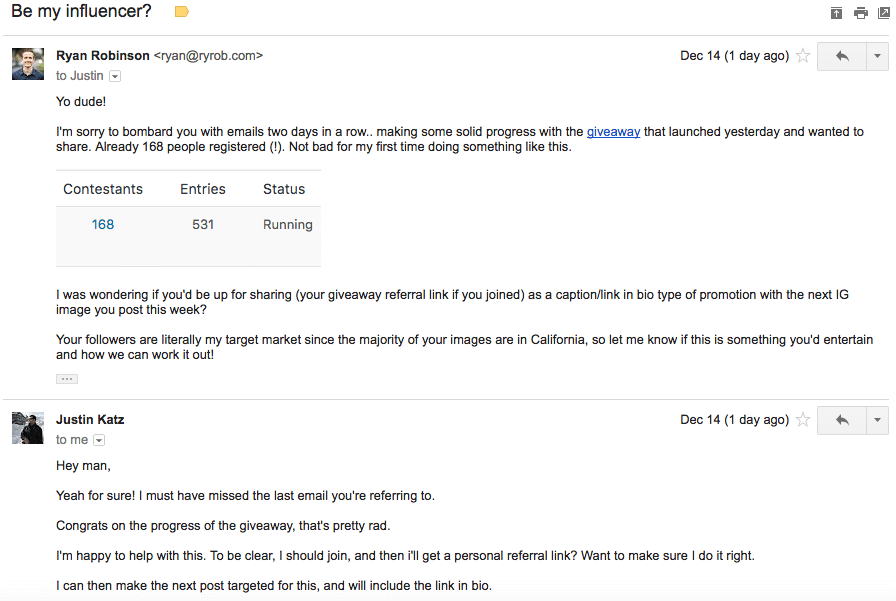
(you can click here to see the full image of the email and read easily)
He was in.
Super simple, I just asked him to post a photo that he’d normally post (less effort) but mention the giveaway in the caption of the image and place the link to enter in his bio for the next 24hrs.
Here’s that feature:

This post already has 484 likes and 18 comments, making it one of Justin’s most engaging posts recently. The image is incredible, but people were also pumped about the giveaway. That jump-started the momentum for the giveaway again, and pushed it past the 300 mark in another 12 or so hours.
But what do you do when you don’t have a friend with a large Instagram following already?
Here’s what I’m doing: Cold pitching people who might realistically be interested in sharing my giveaway, in exchange for something valuable to them.
Realistic means that you’re not reaching out to people with hundreds of thousands or millions of followers. For them, their Instagram account is probably a full on business, which means you’d have to pay to play. Set realistic goals.
To me, that meant targeting more influencers that were in the 5,000 – 50,000 follower range and had solid engagement.
Now, what kind of value do I exchange in return for them posting to promote my giveaway? Time to once again put my problem-solver cap back on…
What do photographers who are trying to grow their Instagram following (and business) like?
- Money
- More followers
- New business
- Good press features (which can lead to new followers and new business)
Going down that list to figure out what value I can contribute to their business…
I know that I don’t want to pay for sponsored posts (which would be much quicker & easier), because I hate spending money. That’s out.
I don’t have an existing Instagram account (or website) yet for this project. No followers of my own to push towards these influencers. That’s out too.
I couldn’t think of a quick way to help these guys get new business right away, though there could be something there. That’s out for now.
Good press features. Now that’s something I could promise them (in the future) since the upcoming website I’m working on will have a cleverly named blog as the main components of inbound marketing.
So my hypothesis is that maybe some of these influencers will share my giveaway with their followers, in exchange for highlighting them in a feature on my site. If I could bring my readers over to follow them on Instagram, that’d be valuable to them.
It’s settled. I decided to try and pitch a handful of influencers on future, non-monetary value I could provide in the form of featuring them on my website.
Even still, this is an incredible long shot since I have absolutely zero proof that this website will ever exist.
I’d have to be VERY convincing.
Time to start finding the right influencers to reach out to.
The first thing I did was go to an Instagram location in California that I knew would be rich with photographers an influencers: Yosemite National Park. Thankfully, you can now access Instagram on desktop, so this is much easier than fumbling around on my iPhone.
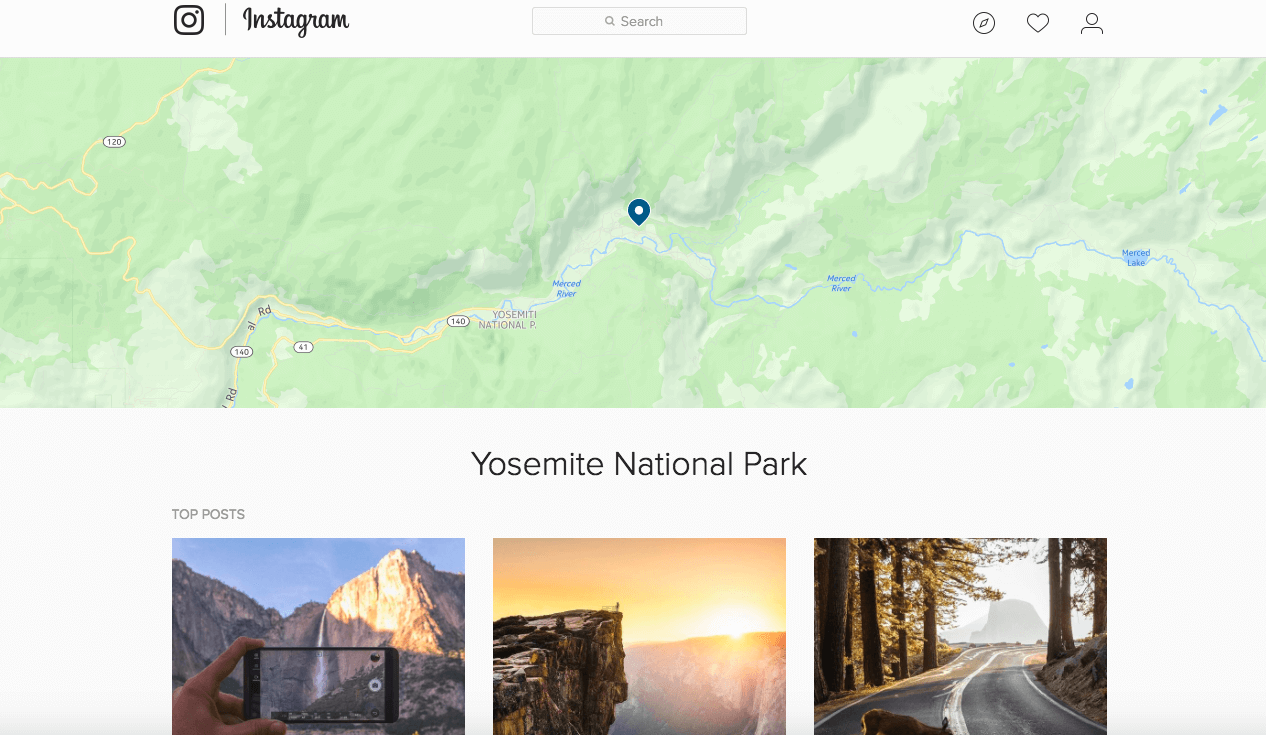
Boom. There are seriously thousands of images post on Instagram, tagged at Yosemite every single day.
I decided to try skipping the top posts at first, because most of those photographers had an insane number of followers and I didn’t think they’d be very realistic to convince to share my giveaway. So, I moved down and started scrolling through recent uploads at Yosemite. As an aside, I’ve finally gotten around to publishing my own guide to the best hikes in Yosemite (on my new hiking blog, Hike with Ryan).
I was looking for photos that had a sizable number of likes in relation to how long ago it was posted—which would tell me that the person likely has a good number of followers.
The first one I came across that fit this bill was right here:

Next, I clicked through to the profile for the person who posted that photo to see if they looked like a good candidate to reach out to. His name is Alex and he has nearly 9,000 followers. A lot, but not unattainable to reach out to. More importantly, he had great engagement with his photos.
Here’s his profile:
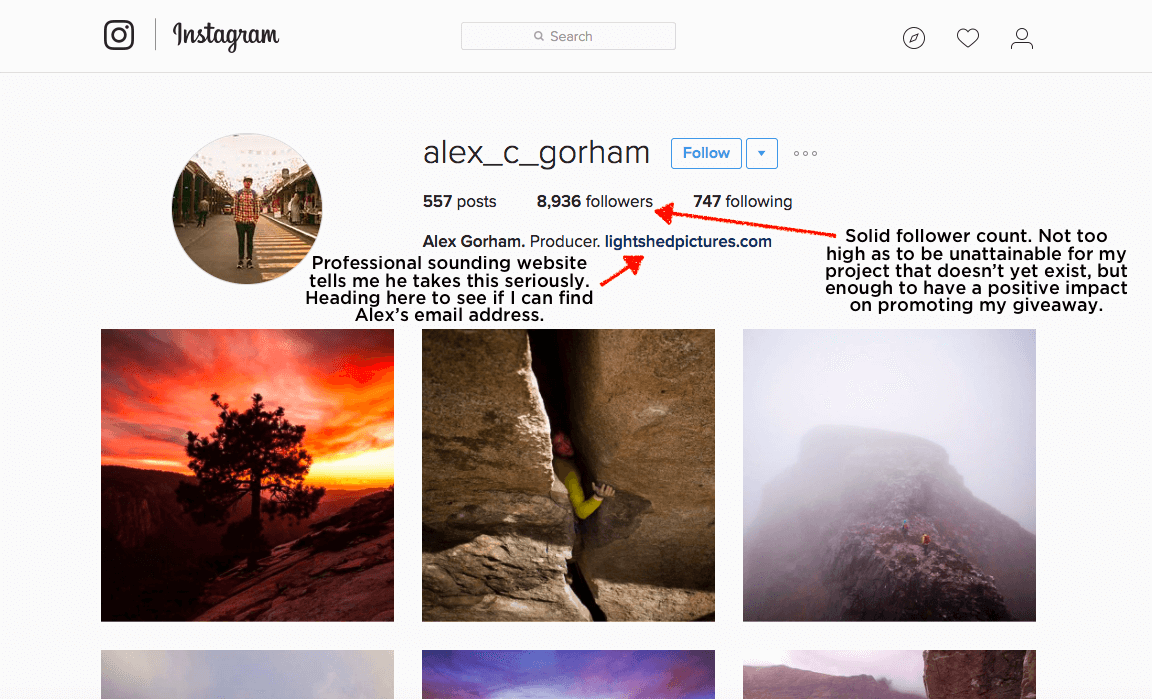
Green light. Let’s give this a try.
Next, I went over to the website he links to in his bio to see if I could track down his email address.
Unfortunately, it was nowhere to be found. However, there was an email address listed for his business partner, Jen.
So I decided to shoot Jen an email with an introductory pitch.
IMPORTANT: I did not immediately reach out and ask to have my giveaway shared (resisting my urge to be selfish and ask for what I want). They don’t care about my giveaway. Like all of us, they’re selfish too… so I want to talk first about what they want—not what I want.
Finally using that new Gmail account I set up for this project, I started my email with a quick complement and referenced a project they’re working on right now, to show that I took an interest in them.
Next, I jumped into why I’m reaching out & made my ask of seeing if Alex would be interested in getting featured on my new website once it launches. Finally, I wrapped it up by name-dropping a few photographers I had gotten to work with during my last job at CreativeLive (and I really do have connections to still).
Note: Never lie to people or make promises you can’t keep. I’m going to follow through with featuring Alex on my site once it goes live if he’s up for it—you have to honor your commitments.
Here’s the exact email copy I sent:
Hey Jen!
I came across a recent photo that Alex posted from Yosemite on IG earlier today and I love the work you’ve both been doing with Light Shed. I’m pumped to see your Psycho Vertical project come to life 🙂
The reason I’m reaching out is because I’d love to feature Alex (and yourself, but I couldn’t find you on IG) on a new website I’m currently building, Let’s Hike California. It’s not live yet, but I’m working with several photographers and producers to document all of the best adventures & hikes California has to offer in stills, video, drone footage and 360 cam images.
Right now, I’m building my list of cool photographers to do features on when we go live—do you think this would be something Alex and yourself would be interested in?
In my previous job at CreativeLive, I worked with photographers like Chris Burkard, Art Wolfe, Frans Lanting and others whom I’m working on lining up features with as well.. so this is going to be a blast!
Let me know what you think,
Ryan
Here’s the full screenshot of how that conversation evolved…
I could go into a ton of detail about the nuances of this conversation, but for now I don’t have time ?
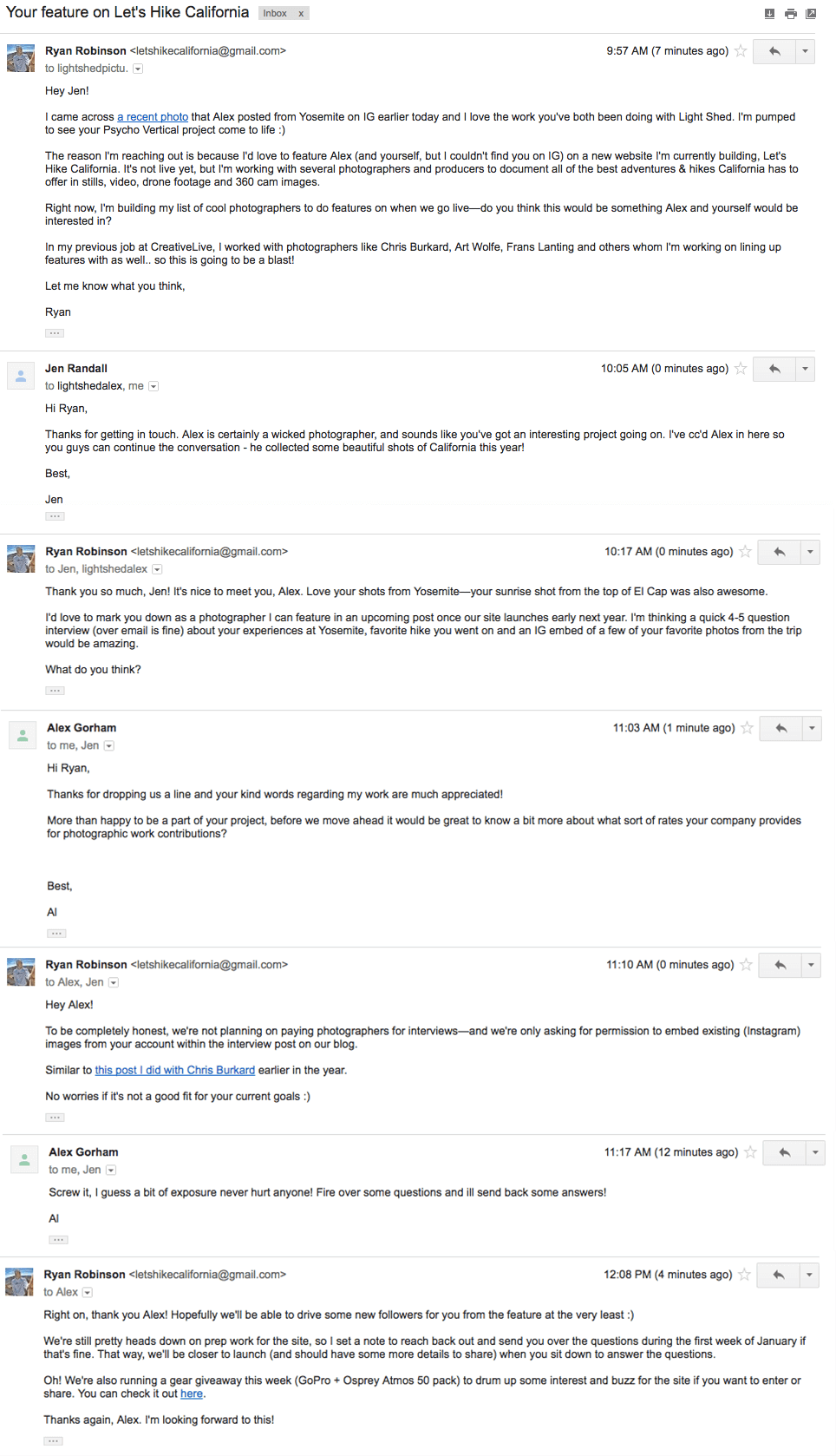
(you can click here to see the full image of the email conversation and read easily)
After a shaky start, the conversation ended with Alex agreeing to do a free feature on my website once it goes live.
I saved my ask for promoting the giveaway until the very end and this was just a couple hours ago, so I still haven’t heard back from Alex on whether or not he entered/shared. I’ll update this when I do hear back!
I’m thinking it’s still a pretty long shot that he’d share it with his audience, but we’ll see. This is a fun experiment and I made it pretty far with my first prospect here. This morning, I sent this basic outreach email (customized for each person) to 9 more influencers, so we’ll see what type of response I get with more numbers.
I now have the basis for a system to perfect and repeat with this process, and it might work if I reach out to enough people.
Only time will tell. More influencer outreach to come this weekend.
For now, I need to get back to work if I want to actually validate this business idea on time!
…
…
UPDATE #3: 565 Email Subscribers, Ending the Giveaway, Finding a Product Idea, Building a Proof of Concept, $108 in Book Pre-Sales, Holiday Vacation and a Big New Opportunity.
Dec 30th: The last couple of weeks have been pretty crazy on all fronts so let’s take this one step at a time.
To start off this update: I was successful in validating this business idea.
For now, let’s go back a few steps and talk about how I got there.
How I built a list of 565 email subscribers in 2 weeks.
A total of 513 people entered my gear giveaway.
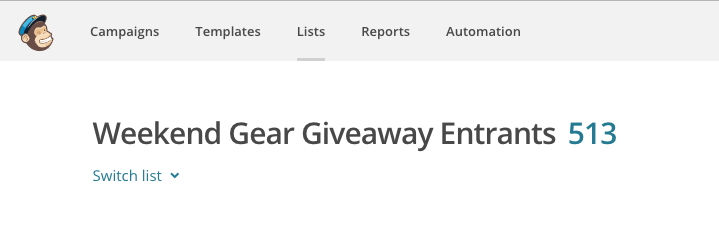
On top of that, my manual list building efforts with friends & acquaintances had grown to 52 subscribers (minus duplicates from those who entered the giveaway).
That brought me up to a total of 565 email subscribers.
We ended the last update with the gear giveaway (a GoPro and Osprey pack) still open. I had secured one influencer promotion on Instagram from a friend who’s a talented outdoor photographer in California—perfect demographic for me.
His Instagram post (and giveaway link in his bio) drove in 38 new email subscribers who entered my gear giveaway after seeing his post. 484 people liked his post promoting the giveaway, so 38 people joining would be a 7.85% conversion from like-to-signup. This is great considering I was leveraging an existing relationship that didn’t cost me anything.
What about the other Instagram influencers I didn’t already know?
Alex Gorham, one of the other Instagram influencers I reached out to (in the last update above) also entered the gear giveaway on the last day it was open. Alex didn’t promote the giveaway very heavily after joining (or post on his account about it) and since there were only hours left by time he joined, I didn’t feel comfortable asking him to do more.
More importantly, as one of my readers Sid Jacobson pointed out in the comments section below—I had just established a little bit of trust and rapport with Alex by offering to interview him for my upcoming website (a little bit of value).
Immediately asking him to share my giveaway would likely explode all of that trust I had just built. It would seem a little disingenuous given my website doesn’t actually exist yet, right? Major no-no on my personal business ethics, so I’m glad I didn’t go through with it.
If I were to use this cold Instagram influencer outreach strategy again, I’d give myself way more lead time and reach out to the people I want to promote my giveaway weeks before the giveaway even started. I’d build more of a relationship with them before making an ask—on top of that, I’d ask them directly how I can provide value to them & their business.
I’d get my website live before reaching out, that way I’d be able to immediately follow through with the interview questions and have a published piece of content for us both to promote.
Important: In your business, getting more established people to help you build your own audience will be all about building relationships and providing value, which are both very powerful long-term strategies. I was working under the confines of a 30 day challenge, so I made some sacrifices I wouldn’t normally make if I was building this without time limitations.
Of the other 9 Instagram influencers I reached out to with the same customized template as my conversation with Alex, only 2 got back to me, albeit after the giveaway had already ended. What’s important is that I still had great conversations with them, which will lead to mutually beneficial interviews in the coming months.
That brings my total up to 3 out of 10 influencers who responded to my cold email—a 30% response rate.
One of the influencers is Zachary Domes, an amazing commercial and outdoor photographer who has almost 42,000 highly engaged followers. Photography is his core business and he’s definitely someone I’ll want to associate my brand with.

Zachary also lives in San Francisco (where I live) so I used that mutual connection to suggest we get together over the coming months to chat about my site & do our interview in person. Here’s his reply to my cold email.

The other influencer who got back to me is Ed Rader, who appears to primarily be a hobbyist photographer (assumption based on not having a website linked in his bio)—but a very skilled photographer nonetheless.

Ed also lives in the bay area, so I was able to use the same localized connection approach and suggested we meet up to chat about my project in the new year. Here’s his quick reply to my cold email.

All in all, my Instagram influencer outreach netted 46 new email subscribers—almost all of which came from the influencer I already had a relationship with.
If I switched up my approach the way I outlined above and had a live website to boost my credibility before reaching out, I’m confident I’d be able to get better results next time.
Regardless, the giveaway continued to pick up pace thanks to the viral sharing tools that are built-in.
Ending the giveaway and earning back what I spent on gear.
By time the giveaway ended, I had 518 entrants.

After scrubbing the list of a couple of duplicates and spammy looking email addresses, that brought it down to 513 unique entrants in the giveaway.
I used the built-in random selection tool to choose a winner and reached out to them to confirm they wanted to accept the prizes.
After the winner confirmed, I bought the GoPro ($184.99 with tax and shipping) & Osprey Atmos pack ($259.95 with tax and shipping) for a total of $444.94, which would have put me at $8.41 over budget for the $500 I’d allocated to validating this business idea.
Total dollars spent was now sitting at $508.39 for this project.
However, because I hate spending money, I chose to sell some stuff and earn at least an extra $400 this month, remember? I was also planning on brokering a discounted deal on this gear from local retailers.
Well, shit happens and I didn’t have time to visit or reach out to stores and secure discounts like I thought I would.
But last week, my never-worn pants and shoes both sold on eBay. That instantly recouped $95 of the money I’d spent on the giveaway items which brought me back down to a total of $413.39 spent.
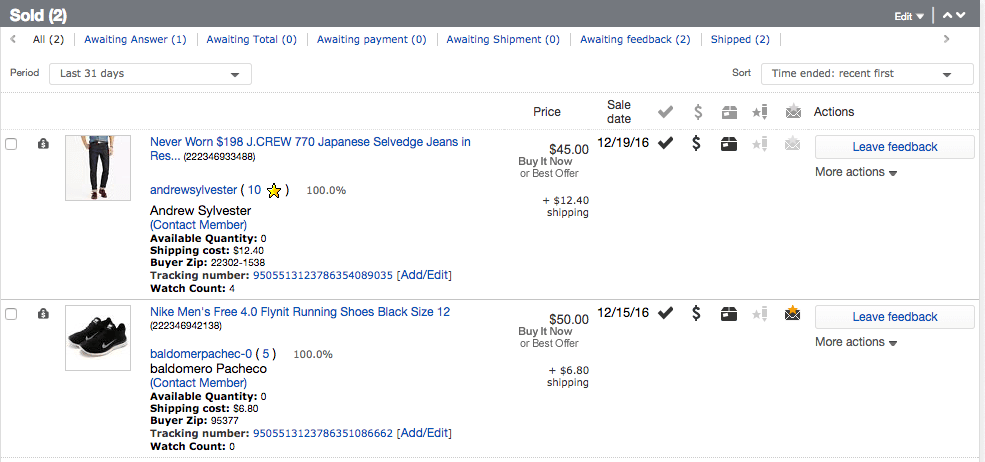
In the last update, you saw that I reached out to a brand I used to do some freelance writing for—in order to see if I could secure a quick paid post that’d boost my income and recoup some more of the giveaway costs.
I used to get paid $250/article with this particular brand when I wrote for them last year, but I was able to negotiate $400 for the new article I pitched them last week. Boom.
That means I had now recouped almost everything I spent validating this business idea.
Now, I was sitting at just $13.39 in expenses that I’m out for this project.
Remember, you can’t afford to waste time making excuses for why you can’t achieve your goals.
You have to become the master problem-solver in your business (and life). It’ll take creativity, sure. But if you dedicate yourself to kicking ass on small, incremental wins that path you towards eventually creating something great, you’ll get there.
I needed to do everything I possibly could in order to build my email list (goal #1), which meant spending some upfront money on giveaway items—I put it on my credit card, so nothing was actually deducted from my checking account yet.
Then, I used my skills to recoup those expenses in less than 1 week from a totally unrelated business.
I used my skills to fund validating this business idea extremely quickly.
You can do the same in your own way.
Finding a product idea and having more 1-on-1 conversations with my audience.
Now that I’d built a solid list of 565 email subscribers, I needed to figure out what exactly I was going to sell to them.
To be completely honest, I spent half of this month without even thinking about what that product or service would be.
I got a couple of suggestions from friends who I shared my site idea with, so I decided to start with those and see if they resonated with some of other the people in my audience. Here were those two product ideas…
1. An off-the-grid digital guide to the most under-appreciated, top adventure destinations in California.
2. A monthly subscription service that’d plan you one curated local weekend adventure per month.
Before doing anything else, I revisited a core belief of mine that’s been built over years of experience…
In order to build an eventually profitable business, you need to work directly with your (potential) customers at every stage to build and deliver exactly what they want.
So, my next step was to reach back out to a few of my friends I had been updating throughout the month to get their opinion on which product idea sounded more appealing to them.
Here were their responses:
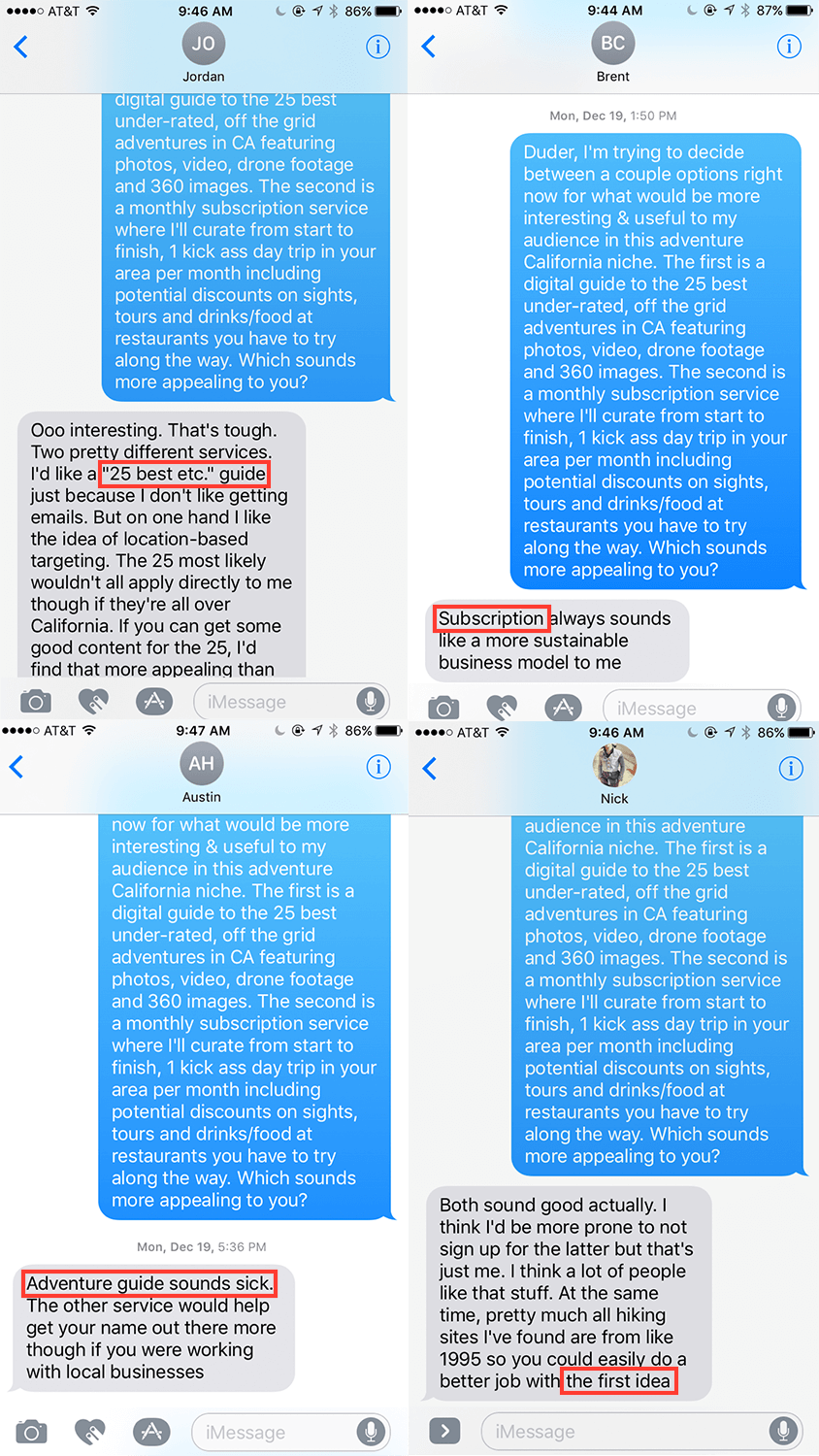
The adventure guide won 3 to 1 over the subscription service.
It was settled.
Now, how do I build a super cool adventure guide in the next couple of weeks? Answer: I don’t.
Before investing any time or money into building a product, I want to first validate that enough people would be willing to pay for this guide. I want people to vote with their wallets before I go out and build something that might not be appealing to enough people for me to have a legitimate business.
Don’t get hung up thinking that it’ll be too difficult to pre-sell a product or service, and that you should just take the time to build it first because it’d be “easier to sell the finished good.”
The purpose of validating a business idea is to avoid wasting time and money.
To make sure you’re not building a solution to a problem that doesn’t really exist—and you need to get people to pay for your solution to show you that they’re actually serious about wanting it when it comes out. We’re looking to build confidence in your business idea here.
Plus, if you can pre-sell something before it even exists, based purely on your enthusiasm, energy and ability to convey confidence with your customers that you’ll deliver a solution they’ll like, you’ll have no trouble scaling your business in the future.
So, this all means I’ll need to pre-sell my adventure guide to enough people for me to have reasonable confidence that there will indeed be a market for this product.
This reasonable confidence level needs to be physically represented by a validation goal, which is the number of pre-sales I’ll need to hit in order to validate a business idea—a core principle we cover in The Launch Formula.
For me, I felt that if I could get 10 people to pre-order my guide, that would be enough to confidently move forward.
My validation goal is locked in at 10 pre-sales.
What comes next?
Time to build a proof of concept so I could actually validate this business idea.
Next, it was time to build a very simple proof of concept that’d serve as a tool to outline & highlight exactly what this adventure guide would be.
A proof of concept is a realization of your method or idea that demonstrates its feasibility. Its purpose is to verify that your concept has the potential of being used (not a guarantee of future success, but rather an affirmation that what you’re creating could turn into your eventual business). A proof of concept is usually small in scope and it’s generally not a finished solution. It’s designed to solve the most basic form of the problem your business is hoping to solve—perfect for when you need to validate a business idea.
The primary purpose of my proof of concept will be to convince my new email subscribers why they need this guide. The selling points, the change it will create in their lives, the benefits they’ll get from reading it.
So, I took a couple of hours and wrote out a simple Google Doc Proof of Concept that was just a few pages long (you can check it out and grab the template for it right here).

I pulled in some of my Instagram photos I took at cool California destinations from the past year or so to help tell a more visually compelling story and give people a more clear idea of the types of places I’d be including in the guide.
Important: At the end of the proof of concept page, I wanted to include a link to where people could immediately go and pre-order the guide. Giving readers the option to go and buy the guide without me first directly asking them to purchase would tell me a lot about how excited they are for this guide.
To keep things as simple as possible, I took 15 minutes to set up a product page on Gumroad, an extremely easy-to-use platform where more than 24,000 people have set up online stores to sell both physical & digital products.
I chose Gumroad because they have the quickest setup time in my experience, and I knew they offered the option to pre-sell products without charging the customer’s credit card until the guide is actually finished—something I really wanted to highlight to my potential customers so they’d know they’re not getting scammed.
I also had to choose my price point for the guide.
I wasn’t too worried about the dollar amount I earned from pre-sales of the guide, since my goal at this stage is to validate my idea—not make ten thousand dollars from it this week.
The dollar amount isn’t important—hitting my validation goal of 10 pre-sales is important.
I want to reiterate again, that the only thing that mattered at this stage was validating my business idea—not earning thousands of dollars from this today. This is a step that so many aspiring entrepreneurs neglect to see the importance of, which often leads to failure, loss of motivation and disinterest in an otherwise great idea.
Many of us can’t even imagine the idea of selling a book for less than “what other experts are selling their books for” or selling online courses for below “market rates,” but this line of thinking is inhibits you from properly validating a business idea (if you have no established audience of your own).
You have to use the tools at your disposal, especially as you’re just getting started and seeking to validate your idea. One of those tools is choosing to offer an otherwise too low price point for your product or service when you go out to pre-sell it to early feedback subscribers.
That discount is in exchange for giving you a vote of confidence and waiting a bit while you actually produce the product—in turn, you get to prove that there is a paying market for your product before investing in it. It’s a win-win.
So, as a starting point for pricing my digital guide, I decided to take a look around and see exactly what others were charging for similar hiking-related guides and see if I could price myself in the same ballpark.
I took a few minutes to do a little research and found that Lonely Planet, an outdoor reviews site amongst many other things sells their digital eBook destination guides for $8.99 on average.

Despite knowing that my guide would explore California’s destinations in new content mediums, with greater depth and more careful curation, I decided to (again) keep things simple and price the pre-sale of my guide right at $9 since that’s what many consumers are currently conditioned to for a guide of this type… if not free even.
I made it clear on the product page that the price point would be higher ($29) for the guide once it’s finished, to increase the urgency for those who are interested in it to pick it up right now.
Here’s what that product page looked like (it had the same copy & images as my proof of concept Google Doc):

Now that I had my proof of concept Google Doc and a live product page ready to go, it was time to try and drive in some sales.
Before emailing my big new list, I wanted to go back to the 4 friends I had consulted on which of the two product ideas sounded more appealing. I texted them a customized variation of this—skipping the proof of concept Google Doc and linking them straight to the purchase page to see how they’d respond:

1 of them bought after sending out this text that included the link to the Gumroad product page.
That gave me a little boost of confidence, but I wanted to see how much I could accelerate this now.
Next, I revisited ~15 of the individual email conversations I had going with the friends & acquaintances who’d joined my early feedback group. I wanted to stick with manual conversations before moving to bulk emailing of my new list because I was still familiarizing myself with selling this guide & learning what was most attractive about it.
Since some of these people I’d reaching out to via email weren’t my closest friends, I didn’t want to immediately ask them to directly buy my guide. I wanted to ask for their opinion and gather their feedback first.
So, I turned to using my Feedback to Pre-Order Sequence (you can download the copy/paste email scripts right here) I use to pre-launch courses and other products. It’s another extremely useful strategy & toolset we cover and use in much more depth within The Launch Formula when it comes to learning how to quickly validate a business idea.
Here’s how the Feedback to Pre-Order Sequence works:
Step 1: Ask the person to read through your proof of concept and complete a short survey leaving feedback about it.
Step 2: Genuinely answer their questions (from the feedback survey) and ask them if they’d be confident enough in your [product] to pre-order it at a discount today.
That’s it. So simple it’s ridiculous.
Important: In the survey, it’s incredibly important to ask the yes or no question of whether or not they’d buy this [product]. You can prioritize your time on the people who pre-qualify themselves as being interested in buying.
Meet their objections head on and be honest about whether or not you think your solution will be a good fit for them based on the feedback they’re giving you.
Now, here’s my Feedback to Pre-Order Sequence in action with a former co-worker and photographer, Matt who’s been giving me feedback on this project for the past couple of weeks.

(You can click right here to view the zoomed in email and read easily)
That now brought me up to 2 pre-orders.
So, I continued to replicate this approach manually with more of my most engaged early feedback subscribers.
The pre-sales continued to climb throughout the day.
Here’s another example conversation I had with a former co-worker, Brooks who’s relatively new to California but loves finding cool new hikes off the beaten path in the bay area.

(You can click right here to view the zoomed in email and read easily)
Did it take a LOT of time having these 1-on-1 conversations with more than a dozen people? Hell yes.
But with every conversation and feedback form that rolled in, I learned something new about both my audience and what my product represented to them. I was getting a step closer to validating this idea each day. A lot of people really resonated with the idea of getting curated adventure recommendations that aren’t mainstream, touristy and crowded—that fueled my motivation every time I got positive feedback.
This process of sparking 1-on-1 conversations made me more effective at identifying the people who’d be the best fit for my guide.
This experience also gave me a more clear sense of how to sell this guide more effectively moving forward—I could see first-hand which selling points were getting the most thumbs up.
By the end of last week, I was sitting at 12 pre-sales totaling $108 in revenue.
I achieved my validation goal (10 or more pre-sales).

I validated this business idea.
Adding this $108 in pre-sale revenue to my figures for this project now puts me into the positive (factoring in the income I drove from selling some stuff on eBay and landing a new paid post to fund the giveaway).
All in all, I earned a net positive $94.61 validating this business idea in 1 month.
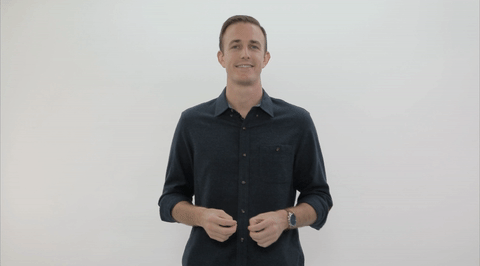
And at a whopping 37.5% conversion rate on the sales page, too. That means most of my viewers were already committed to buying once they landed on the page.
I would’ve kept the manual outreach going beyond just the ~15 people I got to in the first couple of days of pre-selling the guide, but I was coming up onto Christmas and I had planned on setting aside a week of very limited computer time with friends & family (which means a lot to me).
Since I achieved my validation goal through just manual outreach with my early feedback group, I decided to relax and enjoy my vacation time.
If I hadn’t reached my validation goal of 10 pre-sales yet, I would’ve continued the manual outreach to everyone who’d joined my early feedback list and then moved into manually reaching out to the giveaway entrants until I had validated my business idea.
Plus, I’ve been busy working this week on an exciting new project and I need your help again…
…
…
Do you want to validate a business idea of your own in the next 30 days? ?
I’m talking about finding a profitable business idea. Quickly building an email list of real potential customers. Generating revenue in a matter of days. Creating the foundation for what could quickly grow into a profitable business that solves problems you care about.
I did everything in this Validation Challenge in less than 30 days with around 5 – 10 hours of work per week, maximum. And that was with a week-long vacation built in.
All of the money I spent validating this business idea (less than $500) was recouped within the same month and I was able to generate $108 in pre-sales of a book that doesn’t yet exist, to a handful of my email subscribers… thus validating my business idea.
Sound like something you’d like to do too?
If you’ve been wanting to start a business but don’t know exactly what it should be…
If you haven’t been able to get much traction with the idea you already have…
If you feel like you don’t have the time or money to start a business right now…
If you’re just not sure of how or where to get started and you’re looking for a step-by-step game plan to launch…
I’d like to personally help you.
Would you be into that?
I want you to get real results. And if you’re up for it, I’d love to help you do this right now.
Are you ready to finally do this?
Want to find a profitable niche business idea this week? Join my free online course Find a Profitable Business Idea today.
262 replies to “9 Steps to Validate a Business Idea in 30 Days with Less Than $500 (My Validation Challenge)”
Hiking
Cooking hacks sounds interesting.. But I will choose whichever category you decide.I will launch as well as you go along…
How can we get updates on this?
Long distance running..gud luck ryan
Most people would do a web search for cooking hacks.
I think it would be a challenge to create a business around long distance running because of the # of log distance runners.
I think that a hiking tour business could really take off. Lots of tourism and an endless supply of new customers. It would also be fun!
hiking
Hiking in California. From guides to hiking equipment,to photo books!
Cooking!! 😀
All the best 🙂
Running. With a step by step guide from zero to something significant.
I vote for Hiking in California! I could then see this idea spreading to other states and countries. At the end of it all, you could become a traveller who gets sponsored to roam the world. Sky’s the limit – excited to see what happens next!
Cooking hacks! People eat everyday, not everyone hikes or runs. I’m a trained chef and food scientist. Please let me know if you need any help with content!
Topic 1. Hiking in California
1. Hiking in California
Definitely Hiking in California!!
Alll three are good but for different reasons
Cooking Hacks: Interesting to make a business out of something which is crowded
Hiking In CA: Niche market where people would be interested
Long Distance Running: I am a running and wonder how anyone can create monetizable business in a areas where it appears there is a site or services for every distance
+1 for Cooking Hacks! Only because I’m an out of town.
ps– If you do California Hiking tips feel free to reach out about a guest post and link from www.rheosgear.com 🙂
– Jake
Thanks, Jake! I’m thinking I may be reaching out soon for that guest post… hiking California seems to be taking the lead as of now.
Cooking hacks. This should be interesting.
+1 for hiking
I vote cooking hacks but very interested in this regardless.
Very excited to see this in action. Thank you!
Hi there. Hiking seems to very interesting and universal. I’m looking forward with pleasure. 🙂
Hiking!